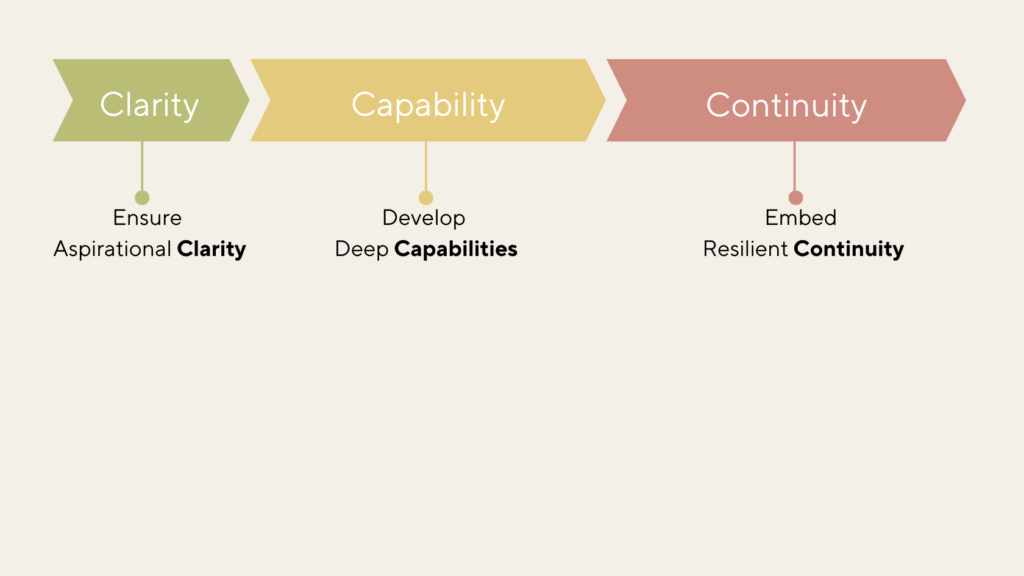Leading AI Transformation

The Appleton Greene Corporate Training Program (CTP) for Leading AI Transformation is provided by Ms. Eriaku Certified Learning Provider (CLP). Program Specifications: Monthly cost USD$2,500.00; Monthly Workshops 6 hours; Monthly Support 4 hours; Program Duration 12 months; Program orders subject to ongoing availability.

Personal Profile
Ms. Eriaku is a Certified Learning Provider and a Certified AI Transformation Consultant. Renowned for her expertise at the nexus of strategy, business design, and innovation. With over 18 years of experience, she has designed and led transformative strategies for public and private sector organizations worldwide, including complex international bodies like the United Nations and Fortune 1000 companies where she advises senior leaders.
She pursued her Master of Science in Information and Knowledge Strategy from Columbia University in the city of New York.
Ms. Eriaku’s signature skills combine analytical rigor with creative foresight to help senior executives navigate and lead through complexity. She draws inspiration from future-focused methodologies and integrative thinking like game theory and applied economics.
Her signature skills include:
• Strategic Foresight & Trendspotting: Identifying emerging opportunities and risks with precision, empowering leaders to act decisively.
• Outcome-Driven Innovation (ODI): Leveraging customer-centric insights to design solutions that drive measurable business impact.
• Complex Problem Solving: Synthesizing diverse perspectives and data to craft actionable strategies for challenging, high-stakes decisions.
• Organizational Transformation: Enabling teams and enterprises to adapt and thrive in rapidly evolving technological and market landscapes.
Ms. Eriaku’s approach is rooted in empowering leaders to reimagine what’s possible, turning frontier technologies like AI into engines of differentiated value, resilience, and growth. Her course, Leading AI Transformation, is designed to equip senior executives like you with the tools and vision needed to lead confidently in the age of disruption.
To request further information about Ms. Eriaku through Appleton Greene, please Click Here.
(CLP) Programs
Appleton Greene corporate training programs are all process-driven. They are used as vehicles to implement tangible business processes within clients’ organizations, together with training, support and facilitation during the use of these processes. Corporate training programs are therefore implemented over a sustainable period of time, that is to say, between 1 year (incorporating 12 monthly workshops), and 4 years (incorporating 48 monthly workshops). Your program information guide will specify how long each program takes to complete. Each monthly workshop takes 6 hours to implement and can be undertaken either on the client’s premises, an Appleton Greene serviced office, or online via the internet. This enables clients to implement each part of their business process, before moving onto the next stage of the program and enables employees to plan their study time around their current work commitments. The result is far greater program benefit, over a more sustainable period of time and a significantly improved return on investment.
Appleton Greene uses standard and bespoke corporate training programs as vessels to transfer business process improvement knowledge into the heart of our clients’ organizations. Each individual program focuses upon the implementation of a specific business process, which enables clients to easily quantify their return on investment. There are hundreds of established Appleton Greene corporate training products now available to clients within customer services, e-business, finance, globalization, human resources, information technology, legal, management, marketing and production. It does not matter whether a client’s employees are located within one office, or an unlimited number of international offices, we can still bring them together to learn and implement specific business processes collectively. Our approach to global localization enables us to provide clients with a truly international service with that all important personal touch. Appleton Greene corporate training programs can be provided virtually or locally and they are all unique in that they individually focus upon a specific business function. All (CLP) programs are implemented over a sustainable period of time, usually between 1-4 years, incorporating 12-48 monthly workshops and professional support is consistently provided during this time by qualified learning providers and where appropriate, by Accredited Consultants.
Executive summary
Leading AI Transformation
It wasn’t just a company; it was a darling of a company- the household name behind every cherished memory. Birthdays, weddings, graduations—Kodak captured them all. For seven decades, it had been synonymous with film, its signature yellow boxes tucked into the cameras of families and professionals alike. In a world where memories were precious, Kodak ruled.

Then in 1975, Steven Sasson, Kodaks very own engineer invented the world’s first digital camera. Although rudimentary by today’s standards, this groundbreaking invention laid the foundation for the entire digital photography industry. Sasson’s invention was a remarkable achievement that foreshadowed the future of photography. And yet, instead of embracing this new future, Kodak hesitated, and buried Sasson’s invention. Terrified of what it might mean for their profitable film business. They had the future in their hands but chose to bury it in fear of letting go of the familiar – convinced that the world would always need film.
By the time Kodak woke up, it was already too late. The world no longer needed film.

Welcome to Leading AI Transformation: The rewiring of organizations to adapt to the new business realities triggered by frontier technologies like AI.
Every business has every reason to be concerned about the growing influence of technological advancement. A decade ago, only two of the top ten companies by global market capitalization managed to hold their spots, with most being replaced by digital-first companies. That list ten years from now may be just as transformed, if not completely overhauled. It’s no wonder, then, that many are heavily investing in AI transformation to inoculate themselves against the looming threat of obsolescence.
But management faces a conundrum: Failure shouldn’t be an option, yet it is the most frequent outcome. Transformations are hard, notoriously difficult to execute successfully as numerous traps can derail their effectiveness. Change, for any human is hard, how much more implementing fundamental, large-scale change in complex organizations, especially with short-term performance pressures at play. Adapt or risk falling behind. That’s the gnawing fear.
But how do the successful succeed? How does one successfully adapt and transform an entire organization to do many things well, many things differently, and all at scale? The fundamental question on the minds of business leaders is: “How can I ensure my organization is among the successful transformers?”
Successful Transformers ensure aspirational clarity, develop deep capability and embed resilient continuity.
This course is the how. The playbook that breaks down the mechanics of AI transformation into the critical success factors that when done right elevate the likelihood of success to over 80%.
Leaders can avoid becoming the next “Kodak”. But success requires more than hope. It requires leading an effective AI transformation: An integrated structured approach. Through 12 distinct workshops, this program equips business leaders with the exact tools, tactics and techniques required to effectively transform the organization to be able to thrive, not just survive AI and frontier technology disruption(s).
But before we embark upon this transformational journey, let’s rewind the clock.
History
The printing press democratized knowledge. The steam engine and spinning jenny fueled the Industrial Revolution. Electricity, the telephone, the telex—each successive wave of technological disruption rewired industries and reshaped societies. Transformation is not new: businesses have been adapting for centuries. So, what’s changed? We’ve moved from analog to digital, from isolated to pervasive, from instructed systems to autonomous ones. For the very first time in history, we have machines that can learn, adapt, and make decisions without direct human instruction. And with this monumental shift comes a distinct set of skills, capabilities, and new ways of working.
It took the telephone 50 years to reach mass adoption, the internet 7 years, and ChatGPT 5 days. Not only are organizations having to transform but the very nature of transformation is transforming.
Current Position
Opportunities and threats abound. Excitement and hesitation. The need to perform and transform simultaneously. Nearly every organization has initiated some form of AI transformation, but few realize the impact they expected, results remain elusive because:

Organizations don’t change, people do. The integrated act of rewiring an entire organization to act, move and operate differently, and as one is part people, part process and part technology.
Leaders often find themselves stuck in the gap between ambition and execution. They understand the power of AI but struggle to move beyond isolated use cases and pilots. Without a comprehensive strategy, these efforts can lead to short-term wins, but they rarely deliver lasting, competitive advantage nor reward the balance sheet.
The heart of this struggle is organization readiness. Many companies are still built around legacy systems, processes, and structures that aren’t designed to support the agility and innovation AI demands. Even when investments in technology are made, the corresponding shifts in talent, operating models, and data governance are often neglected. And then there’s the knowledge gap: AI and frontier technologies like Quantum are new. Few have the full skillset required to work with, not against AI.
The current state of AI transformation is one of untapped potential. The tools are there, the urgency is clear, but many businesses are still grappling with how to unlock real value. The few organizations that have succeeded didn’t just implement technology—they rewired their entire business models, cultures, and mindsets to make AI a core enabler of their strategy.
The Leading AI Transformation Program
This program is designed for the C-Suite and division heads. Whether you’re running a multinational corporation or overseeing a mid-sized enterprise, the principles of this program apply. Over the course of 12 structured workshops, we demystify AI’s role in reshaping your business—helping you move from confusion to clarity. From vulnerable to prepared. The course breaks down the complexity into navigable, actionable insights.
Ultimately, this is about your adaptability, your ability to not just survive but thrive in this new world of frontier technologies like AI. Ultimately. This is about you positioning yourself and not waiting to be positioned.
Future Outlook
We are only getting started with frontier technologies, AI is but one in a long list of upcoming technologies like quantum computing and web 3 and edge computing. The future will belong to organizations that master the art of continuous transformation. Today, AI is leading this revolution, but tomorrow, technologies like quantum computing, advanced robotics, and Web 3 will reshape industries even further. Leaders who understand that transformation is a muscle—one that needs to be continuously developed—will be best positioned to seize these opportunities.
This is not a future where businesses can afford to stand still. The pace of change will only accelerate. The winners will be those who embed agility into their core, creating digital ecosystems where AI and other emerging technologies work together to deliver exponential value.
Transformation is no longer about solving isolated problems. It’s about building integrated capabilities that redefine how businesses operate, create value, and interact with customers. The ability to reinvent—again and again—will be the key to survival.
But this isn’t just about technology. The future of work will rely on human talent—on creativity, ethical decision-making, and leadership. The best organizations will become bionic. Build partnerships between humans and AI, leveraging both to drive innovation and strategy. And as the ethical challenges around AI’s impact on jobs, privacy, and society grow, the companies that address these concerns will be seen as not only leaders in business but also leaders in shaping the future.
The future doesn’t belong to those who resist change—it belongs to those who embrace it. This program is your guide to building the capabilities, strategies, and agility needed to not only survive but thrive in an era defined by relentless transformation.
Core Benefits
We end where we began. The 12 workshops of this program have been intentionally crafted to equip executives with Strategic Clarity, foster Dynamic Capability , and ensure Sustained Relevance in the face of disruptive technologies. The core benefits and outcomes are a direct reflection of the transformational change we seek to manifest in the organizations participating in this program.
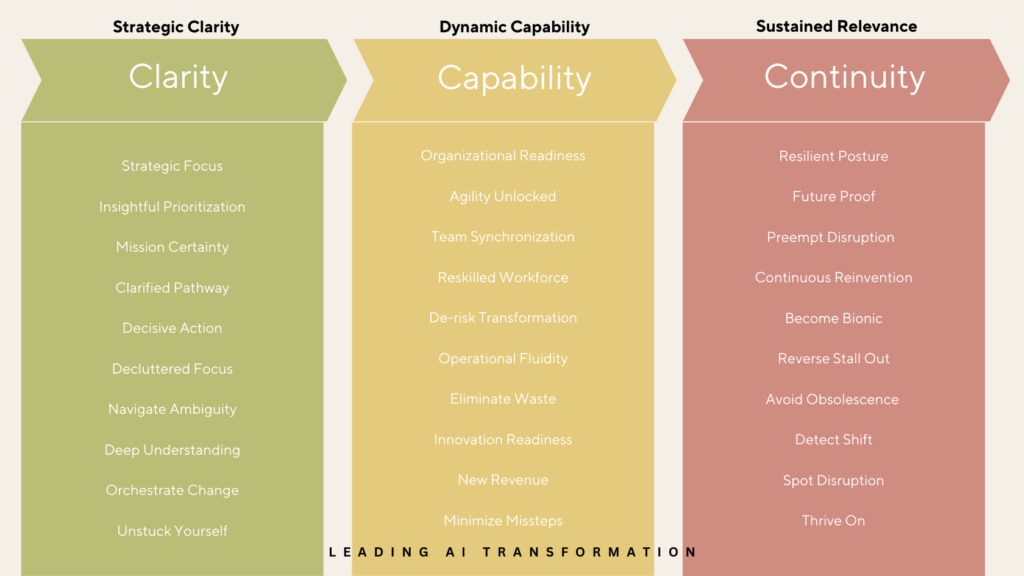
Curriculum
Leading AI Transformation- Part 1- Year 1
- Part 1 Month 1 Vision Engineering (Visioneering)
- Part 1 Month 2 Reimagining Value
- Part 1 Month 3 Road mapping
- Part 1 Month 4 Technical Feasibility
- Part 1 Month 5 Reshaping Operations
- Part 1 Month 6 People Powered
- Part 1 Month 7 Risk & Response-ability
- Part 1 Month 8 AI Project Implementation
- Part 1 Month 9 Measuring Transformation
- Part 1 Month 10 Horizon Scanning
- Part 1 Month 11 Scenario Planning (Tomorrow Today)
- Part 1 Month 12 The Adaptive Leader
Program Objectives
The following list represents the Key Program Objectives (KPO) for the Appleton Greene Leading AI Transformation corporate training program.
Leading AI Transformation- Part 1- Year 1
Program Outline Plan

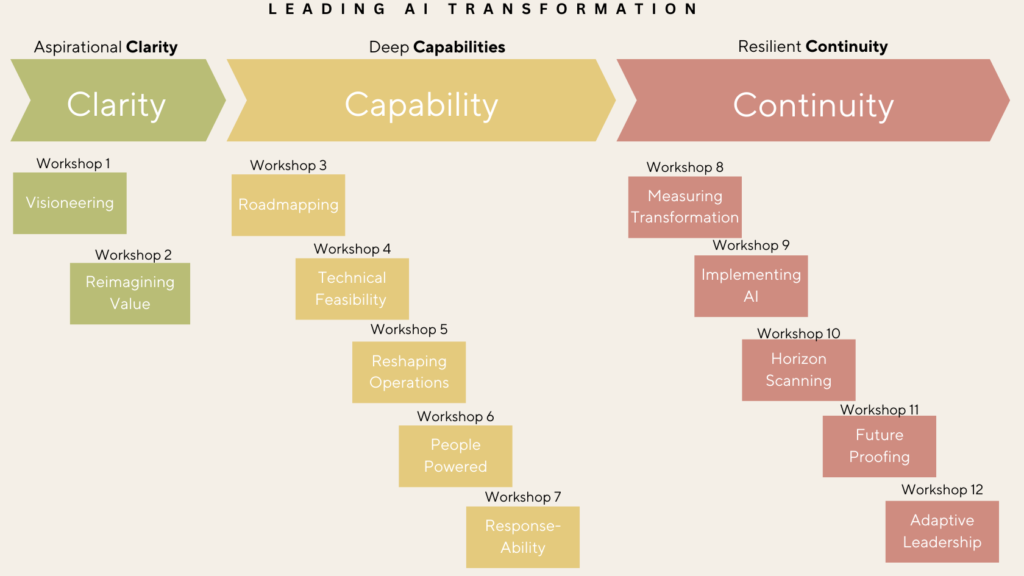

CLARITY
Month 1: Vision Engineering (Visioneering)
The Foundation
The mission of this first workshop is to ignite clarity—clarity that unifies and propels the organization from the front line to the future. Without an anchor, any transformation is doomed. This isn’t just about creating a vision; it’s about forging a vision that electrifies the entire organization with purpose and energy—one that sustains not just for today, but for the lifetime of the organization.
The Fire of Aspiration: What Drives Us? Are we striving for something better, or for something fundamentally different? Do we aim to optimize what exists, or do we seek to innovate and create something the market has yet to imagine? Or perhaps we aim to do both—reshape the internal and the external. These are the questions we will ask and answer during this workshop. Our goal is not to draft lofty aspirations but to create clarity of conviction—one that burns bright enough to illuminate the entire transformation journey.
But to build this clarity of conviction—this clarity of why—one must first understand the landscape, which is why we begin with the bedrock of context:
Demystifying the Frontier: Setting the Context Before any vision can take shape, context is required to inform decisions. We start by demystifying the key technologies driving industry revolutions. From Artificial Intelligence (AI) to quantum computing to edge computing, to blockchain, and Web 3. We demystify these technologies through jargon-free, executive friendly exploration. Understanding this state of play, from threats to opportunities, is foundational to building a vision that’s not only bold but grounded in reality.
At the outset of any transformation, leadership teams often face fragmentation—varying perspectives, comfort levels, and understanding of these frontier technologies. Such fragmentation can impede progress. We go deep into context-setting to break down misconceptions, build a common language, and cultivate shared understanding before diving into the transformative power of these technologies. This creates the alignment necessary to embark on Visioneering—the process of crafting the animating vision that fuels the entire organization.
Visioneering: Visioneering is not about drafting lofty statements to inspire a handful of executives in the boardroom—it’s about crafting an animating vision that moves the entire organization forward with unstoppable energy. We will explore the key characteristics of ‘good’ visions—those that don’t just sit in a slide deck but instead live and breathe, driving the everyday actions of your people and resonating with customers.
This is about reimagining value. What would it look like if you fully seized the potential of your AI and digital transformation? What would success look like? Through visioneering, this workshop will help you answer these questions.
Unified Leadership Alignment: No vision, no matter how compelling, can succeed without full leadership alignment. We’re not talking about surface-level agreement but about genuine, deep-rooted commitment. This workshop culminates in a facilitated leadership alignment session designed to uncover and address any misalignments, conflicting priorities, or gaps in conviction. Real leadership isn’t about consensus—it’s about commitment. Each leader must understand their role in this transformation and be fully accountable for making it happen.
The criticality of this workshop cannot be understated as most transformation failures can be traced back to leaderships lack of clarity and conviction.
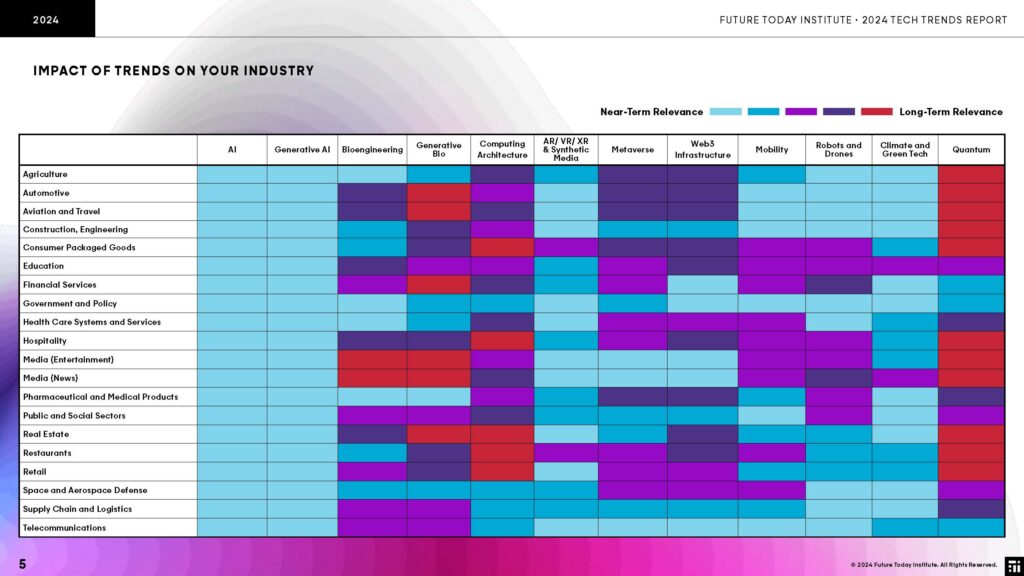

Month 2: Reimagining Value
The question isn’t just, “What do we want to achieve?” It’s where will we achieve it(focus) and how will we achieve it (strategy). Boiling the ocean helps no-one. This is the workshop where we get specific. The objective is to give leaders the clarity and precision to reimagine their business models and determine exactly where their energy and resources should be directed to deliver maximum impact. By the end of this workshop, executives will have redefined their approach to value creation, identified the high-potential domains ripe for transformation, and prioritized their efforts with laser focus.
Rethinking the Core: Business Model Innovation In this session, we go beyond incremental optimization. This is about fundamentally reshaping the very core of the business. We challenge you to ask: What if we started from scratch? What if you weren’t constrained by legacy systems or traditional ways of thinking? Business model innovation is about reimagining how your company delivers value to customers and how it generates revenue in a digitally driven world.
Companies like Netflix, Tesla, and Amazon didn’t just adopt digital tools—they used them to redefine entire industries. They didn’t optimize the existing; they blew past boundaries. Netflix didn’t simply digitize rentals—it transformed how the world consumes content. Tesla didn’t just automate cars—it revolutionized customer engagement and manufacturing. This is reinvention. Your job as a leader is to identify how these disruptive forces—AI, automation, blockchain, and more—can be leveraged to reshape your business model, not just improve it.
Choosing Your Battleground: Domain-Based Transformation is a high-stakes game. Trying to transform every part of the business at once is a sure path to failure. But focusing too narrowly leaves opportunity on the table. The challenge is in choosing where to play—which domains of your business hold the most potential for disruption and growth? Should you revolutionize customer service with AI-driven personalization, overhaul supply chains with real-time data intelligence, or redefine your product development with automation?
This is where a domain-based approach comes in. We help you analyze and assess the most critical parts of your business—those domains where transformation will unlock the greatest value. You will work through a structured Value vs. Feasibility Analysis to map out which areas of the business offer the highest potential for AI-driven transformation, and which are most feasible given your current capabilities and resources. This isn’t about chasing shiny objects; it’s about targeted transformation that delivers measurable impact.
Zero-Based Design: Starting from a Blank Slate In today’s world, simply optimizing existing processes isn’t enough. We introduce you to Zero-Based Design—a radical approach that starts from scratch. Instead of asking how we can improve what we have, we ask: What if we were building it fresh, for today’s world? Starting with the customer and working backward, we challenge you to rethink everything from internal workflows to external customer experiences.
Companies like Spotify and Netflix have mastered this. They didn’t tweak the status quo—they created hyper-personalized, AI-driven experiences that not only meet customer expectations but anticipate them. Through our Zero-Based Journey Design exercise, you’ll envision a blank-slate future for your most critical processes, identifying where AI and automation can create new, dynamic experiences that transform customer interaction and internal efficiency in real-time.
How to Win: Prioritizing Transformation Domains Not all domains are created equal, and not all are ready for transformation at the same pace. That’s why it’s crucial to determine where to play first—which areas will deliver the fastest wins and create momentum for larger-scale efforts. In this phase, you’ll leverage the Value-Feasibility Matrix to evaluate each domain against critical factors such as technical readiness, data availability, and talent capabilities.
We guide you through a strategic prioritization process, ensuring that your resources are concentrated where they will deliver the greatest return on investment. This is about stacking early wins in key areas, driving both immediate value and long-term momentum for your broader transformation journey. Take inspiration from companies like ING Bank, which prioritized quick wins in customer service and operational efficiency, creating the foundation for more ambitious, large-scale transformation.
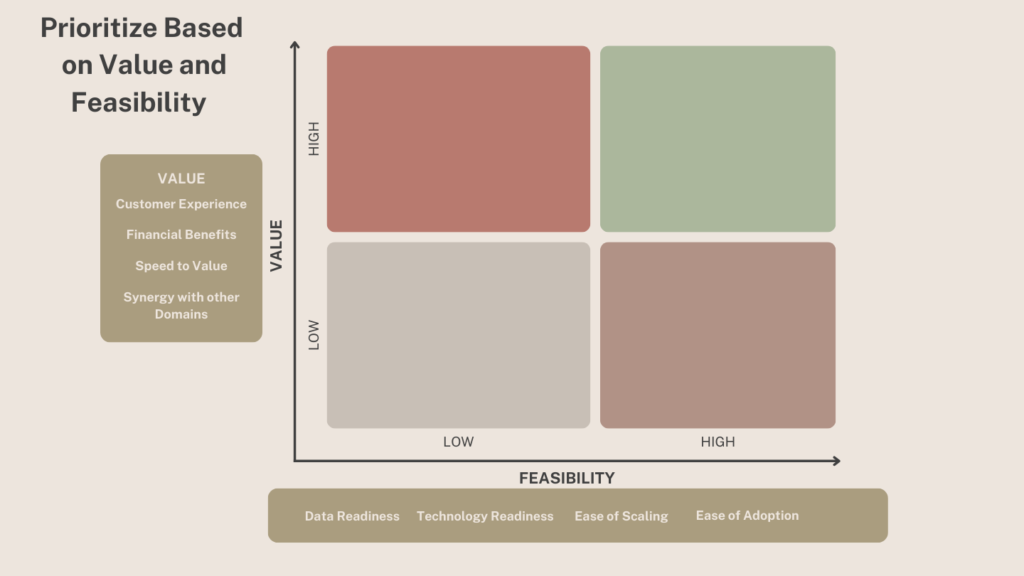

CAPABILITY
Month 3: Road mapping
What Would Have to Be True? For the Transformation to Succeed? The entire premise behind workshop 3 is to ask and answer this animating question a thousand times over, at each key organizational juncture. From talent to culture. In Workshop 3, the shift begins—from vision to execution. The objective of this workshop is to translate strategic aspirations into an actionable roadmap, one that crystallizes exactly what would have to be true for transformational success. This is where aspirations are grounded in reality, where capability building begins, and where leaders create a clear path to bring their vision to life. By the end of this workshop, you will have a comprehensive, phased roadmap, underpinned by organizational alignment and deep commitment.
Turning Strategy into Action: From Realization to Roadmap The most transformative strategies fail not because of lack of ambition, but because they never make the leap from vision to execution. This is where we construct a roadmap that transforms strategic aspirations into tangible, operational steps, backed by deep organizational commitment.
But before the transformation can take root, you need the right architecture to support it. Enter the Transformation Office—the nerve center of your organization’s AI journey. And leading this effort? The Chief Transformation Officer (CTO), a role not just of oversight, but of orchestration, ensuring that every part of the business is aligned, accountable, and moving toward the shared vision.
The CTO’s mission is to bridge strategy and execution. They aren’t just there to track KPIs—they are the architect of change, ensuring that aspirations from Month 1 are fully embedded in every operational component of the roadmap.
Building Capabilities for Transformation: Establishing the Foundation A vision without structure is destined to fail. That’s why the Transformation Office is so crucial—it governs the AI journey, creating the infrastructure for execution. The Transformation Office is not a bureaucratic layer; it’s the operational heartbeat of the transformation, designed to ensure that every initiative, every action, is aligned with the vision. More than that, it creates accountability—ensuring that both top-down leadership and bottom-up execution work in harmony.
Co-Creation and Human-Centered Design Change cannot be imposed; it must be co-created. This is where Co-Creation and Human-Centered Design come into play. Through inclusive workshops, venture marketplaces, and hackathons, the Transformation Office integrates the insights and creativity of employees from every level—especially those closest to customers and day-to-day processes. The transformation isn’t dictated from the top; it’s crafted in collaboration with those who will make it a reality.
Co-creation builds not only engagement but relevance, ensuring that solutions are practical, innovative, and grounded in the lived realities of the business. Employees don’t just buy into the transformation—they help shape it.
Defining the “What Would Have to Be True” (WWHTBT) Framework What separates ambition from execution? Clarity of conditions. The WWHTBT framework is essential in defining the conditions that must exist for the transformation to succeed. It’s not just about setting goals—it’s about ensuring that every step on the roadmap is actionable and rooted in reality. What organizational shifts need to happen? What capabilities must be developed? What mindsets need to evolve? This framework forces leaders to confront what needs to be true—not what they hope will be true—to ensure that every initiative is grounded in success.
Readiness and Gap Assessments: The Reality Check You can’t build a roadmap if you don’t know where you stand. A detailed readiness and gap analysis is conducted to map out exactly where the business is today, and what capabilities need to be built to reach your desired state. This isn’t a surface-level assessment—it digs into five key dimensions:
• Change Readiness: Is your organization truly ready for the scale of transformation envisioned?
• Organizational Capability: Do you have the talent, processes, and infrastructure required?
• Maturity Assessment: How evolved are your current digital capabilities, and where are the gaps?
• Leadership & Cultural Readiness: Is there alignment at every level of leadership? Does the culture support transformation?
• Operational Readiness: Can your operations scale to meet new demands?
The analysis reveals not only gaps but opportunities to close them—whether through upskilling talent, adopting new technologies, or re-engineering existing processes.
Building the Roadmap: From Vision to Execution Once the gaps are identified, the focus shifts to building the Transformation Roadmap. This isn’t just a plan on paper—it’s a structured path to success
The roadmap is built using a Strategy Staircase approach, ensuring initiatives are sequenced based on both value and feasibility.
Unified Leadership Commitment: Alignment for Success No roadmap is complete without full leadership commitment. Using the RAPID framework, decision rights are clarified, and each leader becomes accountable for their part of the journey.
In Workshop 3, transformation stops being an aspiration and starts becoming a reality. This is where strategy meets execution—where vision is translated into action, and the entire organization rallies around a clear, accountable path forward.
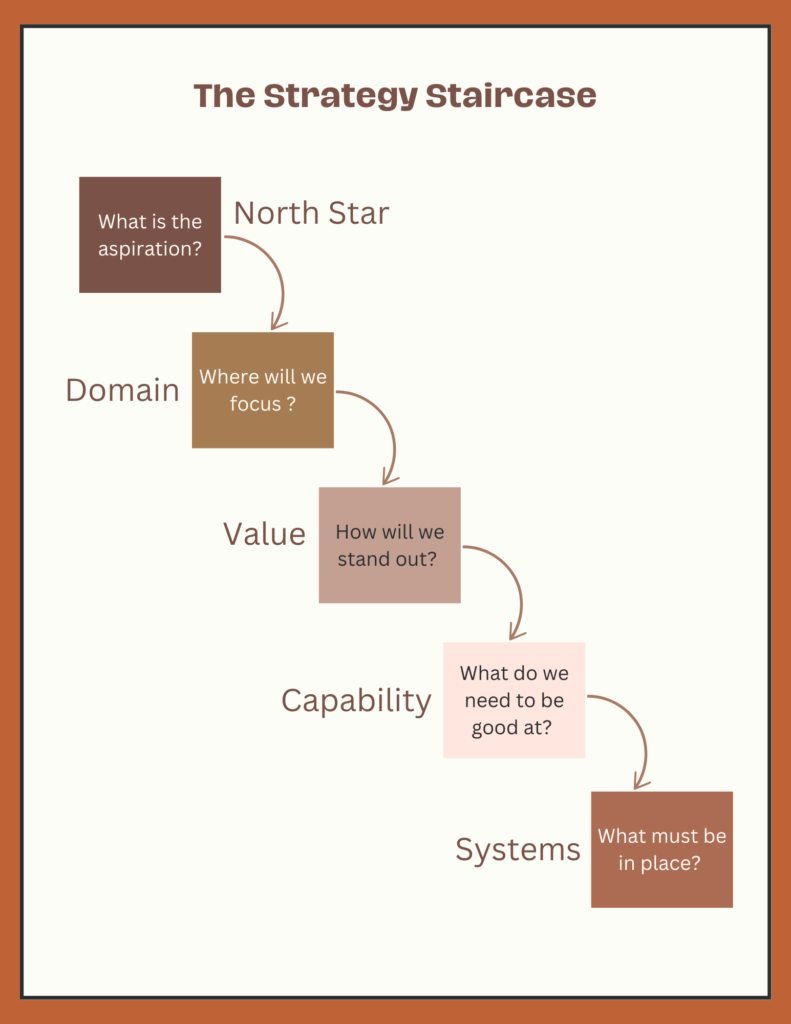

Month 4: Technical Feasibility
This is where the AI backbone of the transformation is built.
Workshop 4 is where we ensure the technology is not just ready for today but engineered to scale with the future. This is where the digital and AI infrastructure built today defines one’s ability to lead in the future. The objective of this workshop is to create a business-led technology and data platform that isn’t just ready for now—it’s engineered for the future. We’re not just talking about tech upgrades; we’re talking about building a technical backbone that scales, flexes, and evolves as the business transforms.
By the end of this workshop, executives won’t just have a tech stack—they’ll have a strategic enabler, a technology core that amplifies their AI and digital ambitions, built to support and accelerate transformation.
Is Your Technology Future-Proof?
This is the guiding question throughout this workshop: Is your technology built to drive real business value, or is it just keeping the lights on? The difference between those two realities is the difference between surviving and thriving in an AI world. In this workshop, we’ll ask critical questions to determine whether the technology architecture is truly ready to support the bold ambitions laid out in the vision.
Some of the questions we will ask and help the learners get answers to are:
Business-Led and Fit for Purpose:
• Is your tech architecture tightly aligned with the organization’s business strategy? Or are you merely upgrading for the sake of it?
• Have you built a platform that’s designed to deliver on both current business needs and future innovations?
• Does your platform provide transparency across products, processes, and organizational impacts?
Built for Frequent Upgrades:
• Is your architecture flexible enough to adapt to tomorrow’s demands?
• Have you decoupled your AI transformation from core system overhauls, allowing both to evolve in parallel?
• Are you using an iterative deployment method to accelerate the release of critical features and drive value sooner, not years down the line?
• Does your operating model support agile, DevOps-driven delivery cycles?
The answers to these questions will tell you whether your technology is a liability or an accelerator for digital transformation.
Designing a Business-Led Technology & Data Platform
Technology is not just a tool—it’s a strategic asset, one that amplifies the business strategy. A business-led technology platform means that every piece of the tech stack is designed with one purpose: to support and enhance the organization’s digital ambitions. This isn’t about upgrading for the sake of shiny new toys. It’s about building an architecture that can evolve alongside the business, supporting new capabilities and innovations as they emerge.
A modular architecture is the key. Rather than allowing legacy systems to hold you back, we’ll focus on decoupling these systems and integrating new, AI-driven components. This ensures the business can embrace the most impactful digital tools without disrupting operational continuity. By the end of this workshop, learners will understand why they need modular architecture and how to support their tech teams to build a flexible, iterative technology platform that can support not only today’s digital initiatives but tomorrow’s unknowns.
Data Readiness: From Collection to Activation
There is no AI without IA (Information Architecture). Data is the lifeblood of every transformation initiative, but most organizations are data-rich and insight-poor. Workshop 4 helps executives wrap their head around the data dilemma and what to do about it. It helps them understand how to transform their raw data into a strategic asset. Simply having access to data isn’t enough—the data needs to be clean, democratized, and actionable across every business function. Through the Ladder Framework, learners will be guided on how they can be data ready.
Strategic Alignment Between Business and IT
For the transformation to succeed, technology and business must work hand-in-hand. Historically, silos between IT and business have derailed countless projects. This workshop breaks down those barriers, helps executives understand the roles, the best-in-class practices of unified business-IT teams and how to operate as one cohesive unit.
Technology Feasibility Audits: Uncover the Gaps
Before one can build for the future, they must first assess where they stand today. The Technology Feasibility Audit serves as a reality check, evaluating whether the current infrastructure, platforms, and tools can support the advanced technologies required to execute on the vision. In this workshop we will demystify technical feasibility and help you know exactly what to look for in technical feasibility and how to monitor and manage the tech team responsible for the feasibility. Consider it as the non- technical leaders guide to understanding technical feasibility.
This audit gives more than just a snapshot of your current state—it provides a detailed Feasibility Report that identifies where upgrades are essential and outlines a clear path forward. After this process, you will know exactly what needs to happen to ensure your technology and data platforms are built for the future.
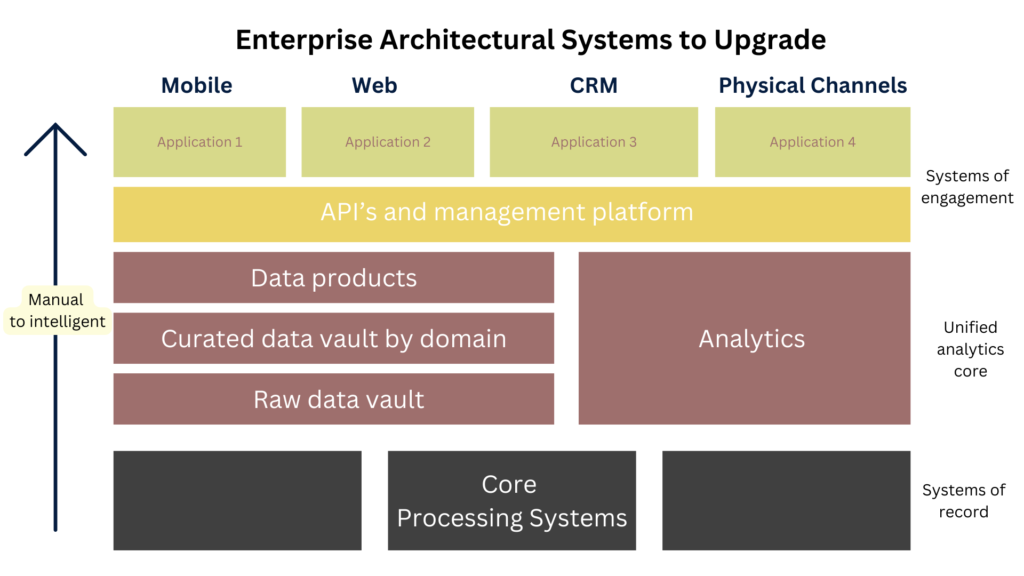

Month 5: Reshaping Operations
What if you could operate better, faster, smarter?
What does it take to liberate the hidden energy in the organization? The energy that’s been trapped in silos, slow approvals, and complex structures.
Having a compelling strategy is great, but it amounts to nothing if no effective operating model backs it up. When the pieces of the operating model come together, when the system is agile and it adopts and moves according to the need, only then does the organization reap the benefits of the strategy, only then does the company build deep customer connections, make decisions quickly, and help employees focus on work that truly matters.
This workshop is about liberating the hidden energy in the organization. The entire objective of this workshop is the liberation that fuels agility and continuous reinvention.
The goal is to transform your organization’s operating model into a nimble, fast-moving engine that connects seamlessly with strategy.
But How Do We Do It?
We start with a Zero-based mindset. This mindset is about adopting a future-first approach, where the past no longer dictates today’s decisions. It’s about shedding organizational inertia and embracing a philosophy that asks, “If we were to design this from scratch, what would it look like?” It challenges every leader and team member to rethink how they work, to question long-standing norms, and to focus relentlessly on what adds value. This mindset fuels agility, drives creativity, and keeps the organization forward-focused, ensuring that every decision, every process, and every role is aligned with where the business needs to go—not where it has been.
And then we go into Zero Based Operating Model Design. This approach takes the clean-sheet thinking of zero-basing and applies it to the entire structure of your organization’s operations. It’s a ground-up reimagining of how the business should function, focusing only on the essential activities that drive the most value.
In Zero-Based Operating Model Design, no process, team structure, or system is sacred. Everything is reconsidered through the lens of purpose and performance. It’s about stripping away redundancies, eliminating outdated processes, and building a lean, agile operating model that is future-fit. Imagine re-engineering your workflows to align perfectly with your strategic objectives, cutting out unnecessary layers of approval, and empowering decision-makers at every level to act swiftly. The focus here is to create a system that not only runs efficiently but also adapts dynamically to shifts in the market, technology, or customer needs.
Often, organizations are stuck in a loop of inefficiency—bogged down by silos, redundant approvals, and outdated processes. This workshop will strip away those barriers. We will explore how to rethink your entire operating structure—across every function and from back office to the front line—creating a seamless connection between operations and strategy. The goal isn’t just efficiency. It’s operational adaptability, the ability to execute strategy while continuously adjusting to new realities.
The Core Components of a High-Performing Operating Model
A modern operating model is more than just processes; it’s about orchestrating all the levers of the business—leadership, talent, structure, processes, and technology—to work together harmoniously. We will explore the six critical components of a high performing operating model.
Beyond Agile
We will explore the fascinating case studies of operating models that go beyond agile—from holacracy, where traditional hierarchies are replaced with self-organizing teams, to the RenDan-HeYi model pioneered by Haier, which connects each employee directly to customer needs and market opportunities. These innovative models redefine how organizations can be structured, focusing on flexibility, empowerment, and seamless decision-making.
And We Will Close Out by Empowering You with the Tools to Select the Right Operating Model for Your Organization
And we will close out by empowering you with the tools to help you determine which operating model is best suited for your organization. It’s not about a one-size-fits-all approach—what works for one company may not be ideal for another. We will introduce a decision-making framework that helps you assess your organization’s needs, competitive environment, and internal capabilities. Through this framework, you’ll gain clarity on when to adopt which model.
This tool will guide you through key considerations—such as the complexity of your industry, the pace of innovation required, and the level of collaboration across functions—to match your operating model to the strategic demands of your business. With this knowledge, you will be equipped to make informed decisions on how to restructure your teams, workflows, and decision-making processes to achieve agility, innovation, and long-term competitive advantage. You’ll leave this workshop not only with insights but with a clear plan of action that you can take back to your teams to liberate the hidden energy in the organization so you can move in unison.
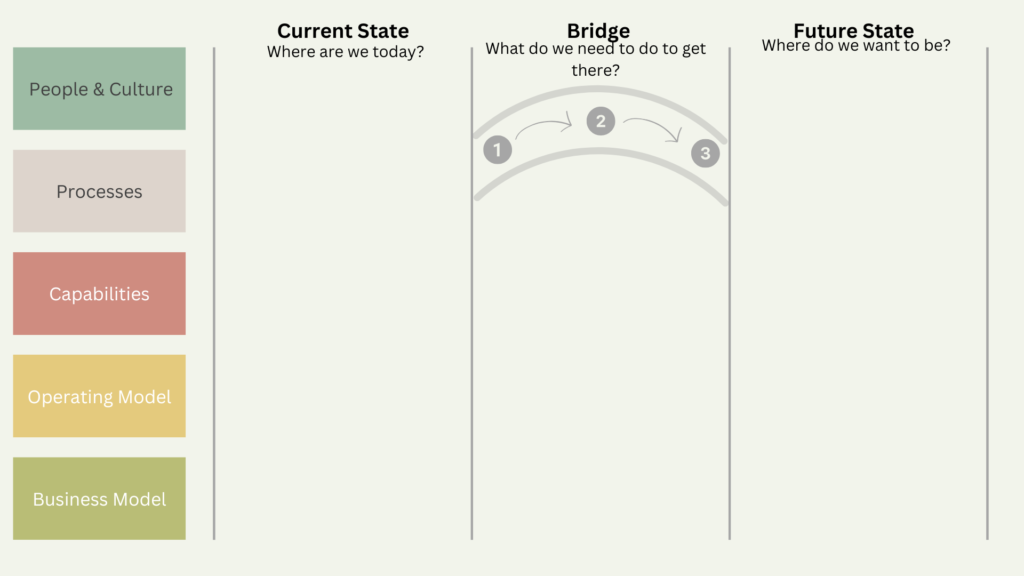

Month 6: People Powered
Organizations don’t change. People do. This month is dedicated to transforming the most valuable resource within any organization—its people. No transformation succeeds without the hearts, minds, and capabilities of those involved. This workshop focuses on equipping teams with the skills, mindset, and cultural environment they need to thrive in the AI future, ensuring that the workforce is not just ready but eager to lead.
What is technology without the people who give it life? The greatest innovations mean little if those who wield them are unprepared, unengaged, and uncertain. And yet, history shows us that every successful transformation isn’t driven by technology alone—it’s powered by people. The beating heart of any organization, the driving force behind every breakthrough, is the collective will and capability of its people.
When an organization embarks on a journey of transformation, it’s undertaking more than the integration of digital tools or the refinement of processes. It’s about unlocking the potential that resides within every individual, nurturing talent, fostering creativity, and building a culture where people not only feel empowered but are inspired to lead.
At the core of this transformation is people power. And for people to embrace the future, they need more than new systems. They need inclusion, trust, and the skills to evolve alongside the technologies they’ll master.
The objective of this workshop is to transform the workforce into a future-ready powerhouse that not only adopts AI tools but leads in their use. This isn’t just about upskilling—it’s about strategic workforce evolution, building the capabilities, mindset, and cultural shifts needed to thrive in an AI world. By the end of this month, you will have reimagined your workforce, ensuring that your people are not just ready for the future—they are driving it.
More Than Skills: Reimagining the Workforce of Tomorrow
Transformation is not about teaching new tricks to an old system. It’s about reimagining the very nature of work and the people who do it. We ask a fundamental question: What does the workforce of tomorrow look like? It’s not just about bringing people up to speed—it’s about unleashing the untapped potential within every individual and rethinking what they can contribute in a world defined by AI, data, and continuous change.
Strategic Workforce Planning: Beyond Simple Skills Assessments
Simple skills assessments won’t cut it in a world where technology evolves faster than curricula can keep up. Strategic workforce planning is the rare capability your organization needs to ensure your people are prepared not just for today’s challenges but for the unknown demands of the future. This goes beyond merely cataloging current skills—it’s about aligning your workforce capabilities with your evolving business strategy, identifying future roles, and building a roadmap for ongoing talent development.
We will engage in skills mapping, where every function—from marketing to finance—will require a new understanding of AI, data science, and digital tools. But this is not a traditional gap analysis. It’s a Talent Futurescape, where you’ll explore the roles that don’t exist yet but will become critical in shaping your business. We will determine how to evolve your workforce, ensuring that you’re not reacting to the future—you’re proactively building it.
This workshop will also redefine roles at every level of the organization. No longer are we talking about siloed functions with narrow responsibilities. The future demands different.
What if your people were already prepared for the future?
What if your teams were more than just aligned—they were visionary?
What if every employee, from the frontlines to the boardroom, responded instead of reacted to the future?
The future isn’t waiting, and neither should your workforce. This workshop is about activating your people. It’s about connecting with the DNA of the organization. It’s about activating the collective intelligence, creativity, and potential of your people to fuel your transformation. Because real change doesn’t come from strategy alone; it comes from people.
How do we prepare our workforce for a world where the only constant is disruption?
It begins by abandoning the notion that your people need to have a strategy handed down to them. That they should adapt to a future that’s been pre-pared for them. This workshop equips you with the tools to Co-create with your team(s) at scale. Turn your workforce into a dynamic, forward-looking engine of transformation, where the future is built, not by a select few at the top, but by the many at every level. When your employees are part of the process, they’re no longer passengers—they’re co-pilots. Their ideas, insights, and energy become the force behind your transformation. And that creates the fuel to make the transformation real.
Team Journey Mapping: The Road to Alignment
Understand the roadblocks, the moments of friction, and the opportunities for breakthrough. Team journey mapping allows you to see the world through your team’s eyes. It’s about empathy at scale. By visualizing their current experiences and pinpointing areas for alignment, you create pathways for smoother transitions, clearer objectives, and a more ‘joyful ’workforce that moves in lockstep toward your transformation goals.
Data-Driven Culture: Making Informed Decisions at Every Level
Every role on the planet will require data literacy. Data has become the lifeblood of organizations, but it’s not just about technology—it’s about mindset. A data-driven culture empowers everyone to make decisions rooted in facts, not hunches. But here’s the real question: Can your people trust the data? Do they know how to interpret it? Do they see it as an enabler, not a threat?
This workshop will show you how to embed data fluency into your organization’s DNA. We’ll teach you how to build a culture where data flows seamlessly through every decision, where insights are shared, not siloed, and where every employee—from the shop floor to the C-suite—has the confidence to work with data. But this requires trust- digital trust.
Building Digital Trust:
Digital transformation means nothing if your people don’t trust the systems they’re using, the AI that informs decisions, or the data that drives strategy. Building digital trust isn’t optional—it’s essential. In this section, we’ll break down how to create a bedrock of trust, ensuring your workforce understands and embraces technology. From safeguarding data privacy to ensuring transparency in automation and AI, you’ll learn how to create an environment where technology empowers, not threatens, your people.
End-to-End Process Impact Assessment: Seeing the Whole Picture
When you change one piece, the whole system shifts. AI transformation impacts every process, every workflow, every person. It is critical to understand the full picture. You will learn how to conduct end-to-end process impact assessments. You’ll assess how technology integrates with human roles and how to plan for it.
Your people aren’t just part of the change—they are the change. And after this workshop, they’ll be ready to work with you in this monumental transformation.

Month 7: Risk & Response-ability
The TRAIFactor Framework for AI Implementation
Is there a feasible solution to bias in AI? What does it mean to be ready for the strategic risks, financial risks, business model risks of AI? How do you ensure that AI isn’t just a tool but a partner in derisking the organization? The questions abound. In this workshop, we both ask and answer them. We deconstruct the key elements required to engineer trust, build robustly for risk and fortify security. Through the TRAIFactor Framework- our unique and comprehensive approach, we tackle the most critical aspects of AI adoption across three essential pillars: Trustworthiness/Responsible AI, Risk Management, and Security & Resilience. These three elements form the foundation of AI’s sustainable and ethical integration into any business, with the framework designed to give leaders the clarity and tools they need to navigate this complex landscape.
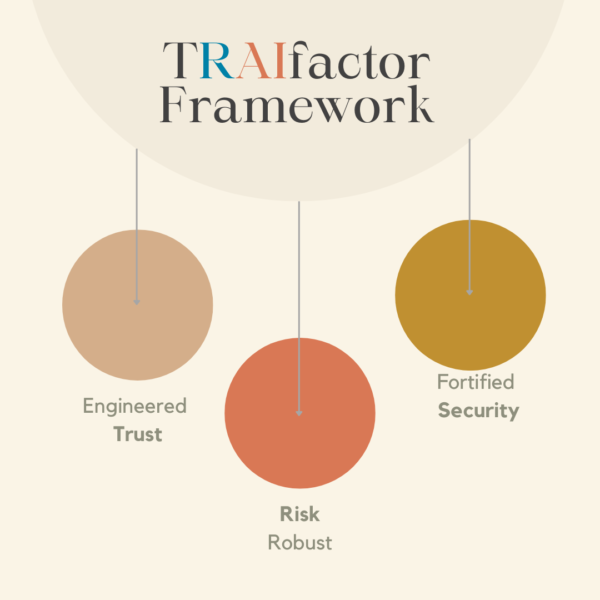
Section 1: Engineer Trust
Is it possible to design for trust in AI?
Trust is the bedrock of any successful AI implementation. Without trust, even the most advanced AI systems will falter as stakeholders question their fairness, ethics, and transparency. But is it possible to design for trust? In this pillar, we show you that not only is it possible, but it is imperative. Trust is not an abstract concept but one that can be architected through deliberate choices in design, governance, and oversight.
We will show you how to embed ethical principles, transparency, and accountability into the DNA of your AI systems. Trustworthy AI is about creating systems that do what they say they will do—fairly, transparently, and consistently. In this workshop, we explore frameworks that have been developed to ensure AI is fair, explainable, and aligned with organizational values and societal expectations. We create a roadmap for how to build AI systems that can be trusted by all stakeholders, including employees, customers, and regulators. This framework highlights five key elements: ethics, governance, fairness, transparency, and accountability. These elements guide organizations in building AI systems that are not only technically sound but also morally grounded. By the end of this section, you will be equipped with both the frameworks and the mindset to design AI that is aligned with ethical standards, fully transparent in its decision-making, and accountable for its impact.
Section 2: Build Robustly for Risk
How do we manage the myriad risks of AI adoption—from business disruption to competitive threats?
Risk is not one-dimensional, and the risks associated with AI adoption are as diverse as they are profound. To fully manage AI implementation, executives must navigate a complex web of risks, including financial, operational, competitive, and even societal risks. But how do you manage such diverse risks without becoming paralyzed by complexity?
This pillar delves into building a comprehensive risk management strategy that accounts for all facets of AI implementation. We introduce a multi-layered approach that covers an array of risks including Business Risks, Operational Risks, Competitive Risks, Legal & Compliance Risks, and the often-overlooked Risk of Inaction.
We examine Business Risk—the potential financial impacts that AI can have on the company’s bottom line. What happens when AI disrupts your existing business model? How do we measure the financial trade-offs of adopting AI, including shifts in customer engagement and pricing models? AI can be a powerful disruptor, but it can also destabilize core revenue streams if not managed carefully. Executives will learn how to evaluate the impact of AI on key P&L items, balance financial risk with innovation, and mitigate the risk of business model disruption.
We tackle Operational Risk, where AI’s influence on workflows, teams, and systems is most keenly felt. AI-driven changes to your operating model can lead to enhanced efficiency—but they can also lead to confusion if not properly managed. In this part of the workshop, you will conduct process impact assessments to evaluate how AI will change not just how things are done but who is responsible for doing them.
We explore Competitive Risk, answering the question: what happens if we don’t act? Leaders will assess how AI impacts competitive dynamics and explore strategies to ensure their organization stays ahead of the curve.
Section 3: Fortify Security
Can AI systems be truly secure in a world of increasing cyber threats?
As organizations become more reliant on AI, they also become more vulnerable. AI systems present new attack vectors for cybercriminals, from data breaches to adversarial attacks on AI models themselves. But can AI systems be truly secure, given these emerging threats? The answer lies in building AI systems that are not only secure by design but also resilient in the face of evolving challenges.
We introduce frameworks for ensuring that AI systems are both secure and resilient. Security in AI is not just about protecting data; it’s about protecting the entire AI lifecycle—from data collection and processing to model deployment and decision-making. Executives will explore key strategies for securing AI systems, including threat modeling, penetration testing, and continuous monitoring of AI models.
We also focus on resilience, addressing the importance of building AI systems that can withstand disruptions, adapt to failures, and continue functioning under duress. In a world where cyber threats are constantly evolving, having systems that are resilient is as critical as having systems that are secure. We’ll walk you through AI-specific incident response plans, helping them prepare for potential breaches, attacks, or model failures.
Through case studies and real-world examples, you will learn how to harden your AI infrastructure and build the necessary resilience to navigate a rapidly changing threat landscape.
The TRAIFactor Framework is the practical guide to implementing AI in a way that is trustworthy, risk resilient, and fortified. This workshop equips leaders like you in doing so.
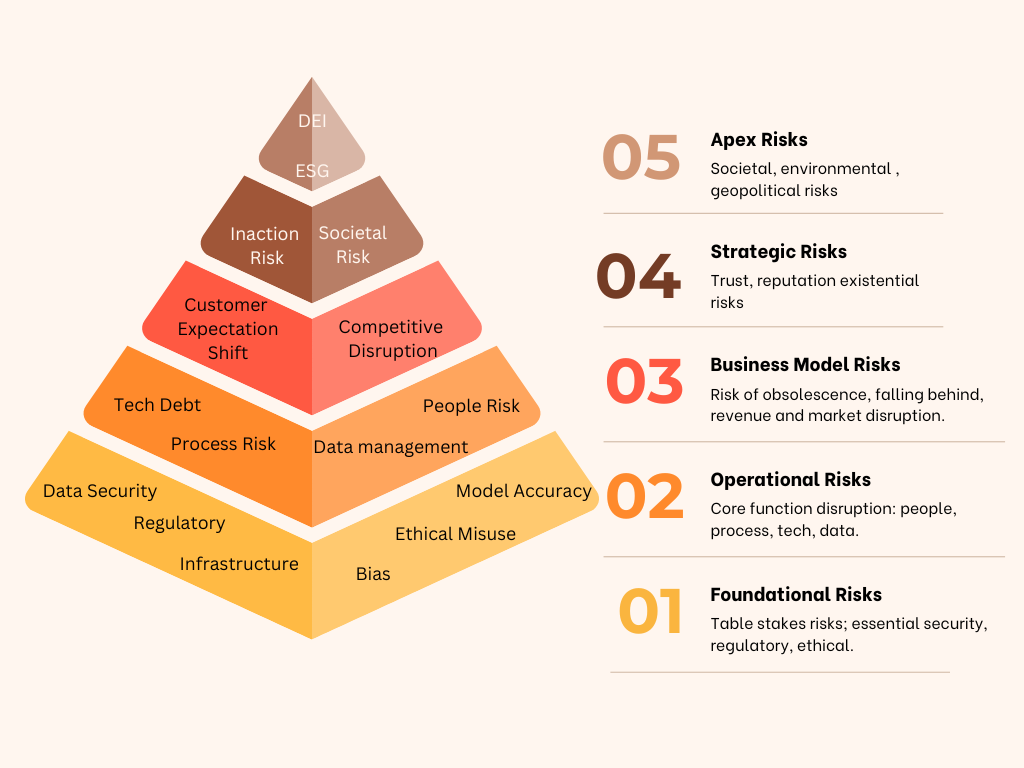

CONTINUITY
Month 8: AI Project Implementation from Concept to Continuous Innovation
How exactly does one build an AI project?
AI projects are different from typical IT or data science efforts because they deal with complex, self-learning systems. These systems are not static; they need to continuously evolve to meet changing conditions and demands. This workshop is designed to help executives oversee AI initiatives from inception to post-launch, ensuring that projects are scalable, adaptable, and capable of driving continuous innovation and business transformation.
What separates an AI project from a typical tech initiative?
AI projects require an end-to-end workflow that accounts for more than just development—they must consider autonomy, continuous learning, and adaptation. The first step in this transformation is defining the problem. But not just any problem—the right problem. Too many AI projects fail because the initial business problem isn’t well-aligned with the true strategic needs of the organization. You’ll learn how to frame these business challenges in a way that leverages AI’s full potential.
From there, data becomes the driving force behind AI’s capabilities. Clean, high-quality data is more than important—it’s essential. We’ll take you deeper than Google or AWS frameworks, covering advanced tools and techniques for gathering, cleaning, and structuring data. You’ll know how to identify hidden biases, fill data gaps, and make your data AI-ready.
But data isn’t enough. The next step is training AI models using cutting-edge platforms like NVIDIA GPUs or Google Cloud TPU Pods for high-performance, scalable AI. And yet, even trained models need continuous validation, especially as they interact with evolving data in real-time environments. This section will teach you how to build systems that can monitor themselves, flag anomalies, and update continuously.
From Concept to Continuous Learning: The Agile AI Workflow
What if AI projects didn’t end with deployment, but evolved with your business?
AI requires a lifecycle approach—AI systems aren’t just “deploy and walk away.” This section is inspired by MLOps, the next-generation DevOps for AI, where models are not only developed and deployed rapidly but also continuously monitored and retrained. By the end of this section, you will be versed in how to set up agile workflows for AI projects, using continuous integration and continuous deployment (CI/CD) methodologies to keep models adaptive and scalable.
We’ll also cover advanced ModelOps—a framework focused on operationalizing models in production, with robust monitoring systems for fairness, bias, and drift detection, ensuring long-term accuracy and ethical alignment.
End-to-End AI Governance: Building for Compliance and Trust
Can AI be trusted? How do you know your AI won’t fail when it matters most?
Compliance and governance for AI extend far beyond ethics checklists. You need a framework that embeds trust and transparency throughout the AI lifecycle. Drawing from frameworks like AI Trism (Trust, Risk, Security Management for AI), this section will teach you how to govern AI projects at a granular level—ensuring data integrity, model fairness, and decision transparency from conception to deployment and beyond.
We’ll dive deep into XAI (Explainable AI) frameworks, ensuring that your models aren’t just delivering results but can articulate how they reached their conclusions—critical for business leaders, auditors, and even legal defense.
MLOps in Action: Supercharging Implementation Through Agile and CI/CD
How do you build AI projects that continuously evolve?
Using MLOps, you’ll understand how to create pipelines for training, testing, and deploying AI models at scale, automating key workflows and reducing friction in the development process. Imagine an AI model that gets continuously smarter with each new dataset it encounters—without needing manual intervention every time.
We’ll teach you how to set up these pipelines and incorporate CI/CD for ongoing updates, ensuring your models don’t stagnate but instead improve over time. Think of it as turning AI from a one-time project into a living, breathing system that enhances itself continuously.
Mastering AI Economics: Navigating the Financial Realities of AI
AI project budgets often hide long-tail costs—compute resources, continuous retraining, AI talent shortages, and the high stakes of misfires. You’ll learn how to spot these hidden costs upfront and deploy solutions such as AI-as-a-Service or hybrid cloud infrastructures to optimize for both scalability and cost efficiency.
But economics doesn’t stop at compute resources. AI’s true cost also lies in talent. You’ll learn how to balance in-house capabilities with outsourced expertise, ensuring you’re not overpaying for AI talent while still maintaining world-class performance.
Real-World Case Studies: Projects that Went Beyond AI Pilots
How did they take AI from a promising pilot to a game-changing competitive edge?
We’ll examine real-world case studies of companies who have mastered AI at scale. From AI-first companies to businesses that are successfully using AI to drive autonomous systems, we’ll break down how these organizations moved beyond pilots and scaled AI into a major force for innovation and profitability. Learn how AI went from an experimental tool to a core business driver.
Ethical AI and Trustworthy Governance: Why Governance is Not a Checkbox
How do you prevent AI from causing harm?
Governance in AI is not a one-time task; it’s an ongoing commitment to building trust. Learn how to weave governance into every phase of your AI projects—building not just ethical AI but trustworthy AI that can stand up to scrutiny. We will provide the tools you need to continuously monitor and mitigate bias, defend against adversarial attacks, and ensure compliance with global AI regulations.
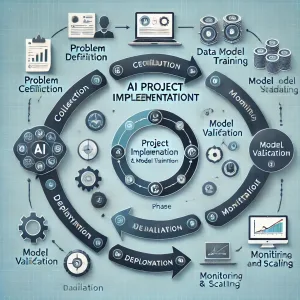
Cross-Functional Teams: Supercharging Collaboration Across Silos
How do you create a team that can turn AI into reality?
AI requires more than tech teams—it needs cross-functional superstars who can see beyond their domains. You’ll learn how to build and lead high-performing AI teams composed of machine learning engineers, data scientists, business strategists, ethicists, and legal experts. This isn’t just about getting the right skills; it’s about fostering collaboration and communication across traditionally siloed teams.
A Strategic Blueprint for AI-Driven Success
By the end of this workshop, you will not only understand the steps to implement AI but will have a blueprint to transform AI from a promising initiative into a powerful, continuously evolving system that drives real-time, autonomous decision-making. You’ll leave equipped with the tools to ask the right questions and ensure your projects scale right and scale well.

Month 9: Measuring Transformation
In this workshop, we tackle the most critical question in any transformation journey: How do you know if it’s working? Transformation isn’t about ticking boxes or celebrating early wins—it’s about ensuring that every step forward is genuine and sustainable. The objective of this month is to empower you to identify the true indicators of success, uncover hidden inefficiencies, and ensure that transformation becomes an ongoing process of value creation and innovation.
By utilizing the ARM (AI Readiness and Maturity) Model, we go beyond simple KPIs to measure your organization’s ability to adapt, innovate, and thrive in a fast-changing world. This workshop arms (pun intended) executives with tools and insights to assess transformation holistically, from cultural shifts to capability building, financial viability, and operational effectiveness.
How Do You Know If It’s Working?
This isn’t just about measuring what’s easy to track—it’s about uncovering what truly matters. What are the indicators of real success, and what are the masks hiding deeper inefficiencies? How do you spot the hidden risks or “watermelon issues”—projects that look green on the outside but are red with failure underneath—before they derail your efforts?
This month, we go beyond surface-level metrics. We dive into how to measure transformation holistically, focusing not just on financials but also on capability development, cultural shifts, and operational agility. This is where transformation becomes tangible, measurable, and manageable.
Defining True Transformation Success
It’s not enough to see short-term gains. Real transformation means building an organization that can continuously evolve, innovate, and adapt. But what does that look like in practice?
We explore three critical indicators:
1. Sustainable Value Creation: It’s about more than immediate wins—can the organization create ongoing value, continually unlocking new growth opportunities?
2. Capability Growth: How well has the organization built internal capacities—whether in AI, leadership, or operations—that allow it to navigate future disruptions and seize new opportunities?
3. Cultural Shift: Has transformation embedded innovation, agility, and future-thinking into the very fabric of the organization’s culture?
We’ll explore how to measure these elements, moving beyond the superficial KPIs that often mask deeper inefficiencies. This isn’t about tracking isolated successes—it’s about ensuring the transformation becomes a self-reinforcing loop of progress and innovation.
The ARM Model – A New Standard for Measuring Transformation
The ARM (AI Readiness and Maturity) Model forms the foundation of this workshop. It evaluates transformation across six key dimensions—Knowledge, Desirability, Feasibility, Viability, Adaptability, and Reliability—ensuring that your efforts are not only impactful but sustainable.
Knowledge:
Transformation starts with knowledge. Do your teams possess the AI literacy, data literacy, and practical skills needed to drive meaningful change? We’ll measure this through:
• AI Literacy: Is your organization well-versed in AI concepts and their real-world applications?
• Data Literacy: Can your teams leverage data to make informed, strategic decisions?
• Practical Application: How effectively are theoretical concepts being applied to real-world scenarios?
These indicators help you assess whether your organization is growing the critical knowledge needed to sustain a long-term transformation.
Desirability:
Is your organization motivated to change, or is it just ticking boxes? Desirability measures the cultural and emotional factors driving transformation:
• Motivation and Vision: Are your leaders and teams genuinely excited about the future of AI in your business?
• Perceived Value of AI: Is AI seen as a strategic necessity or simply a buzzword?
• Resource Allocation: Are you dedicating the time, budget, and personnel necessary to succeed?
By assessing desirability, you can ensure that your transformation isn’t just operational but emotionally and culturally embraced across the organization.
Feasibility:
Feasibility is about assessing whether your organization has the infrastructure, talent, and data needed to support your transformation goals:
• AI Talent: Does your organization have enough internal AI expertise, or do you need external support?
• Data Availability and Quality: Are you leveraging clean, accurate data to power your AI initiatives?
• Scalability: Is your infrastructure scalable enough to handle future growth in AI adoption?
Without technical feasibility, even the most ambitious plans can fail. This workshop will help you assess where gaps exist and how to close them.
Viability:
Transformation must be financially sustainable. In this dimension, we assess whether your transformation efforts are producing positive ROI and whether they are scalable over time:
• Cost vs. Benefit: Are the benefits of AI outweighing the costs?
• Sustained Affordability: Can your organization afford ongoing AI investments over the long term?
• Risk Management: Are you aware of the financial risks, and do you have strategies in place to mitigate them?
With these tools, you’ll ensure that your transformation is not only successful but also financially viable.
Adaptability:
Your organization’s ability to pivot and adapt is crucial. Are your systems and culture built to handle continuous change?
• Cultural Adaptability: Is your organizational culture flexible and open to new ideas?
• Innovation Channels: Are there formal avenues for teams to contribute to AI and innovation efforts?
• Future Thinking: Are you preparing your business for future trends?
This dimension helps you measure your organization’s readiness to adapt to the ongoing evolution of technology and markets.
Reliability:
Can you trust the AI systems you’ve implemented? This final dimension assesses how reliable, ethical, and transparent your AI systems are:
• Responsible AI: Are you adhering to ethical standards for AI deployment?
• Transparency and Bias: Can you explain how your AI makes decisions, and are those decisions fair?
• Security and Privacy: Are your AI systems secure and compliant with data privacy regulations?
Reliability ensures that your transformation is not just innovative but also sustainable and responsible.
Uncovering Hidden Risks: Avoiding the Watermelon Effect
Sometimes the biggest risks in transformation aren’t the obvious ones—they’re the hidden inefficiencies that look like success on the surface but hide deeper failures beneath. We call this the “watermelon effect”—green on the outside, red on the inside.
In this workshop, you’ll learn how to:
• Identify hidden risks that can derail transformation efforts.
• Implement governance structures that ensure transparency.
• Hold leadership accountable for long-term change rather than short-term wins.
Predictive KPIs: Seeing the Future Before It Happens
Measuring transformation isn’t just about looking at the past; it’s about predicting the future. We introduce predictive KPIs that leverage data science and AI to forecast success:
• Predict Outcomes: Know which projects are likely to succeed or fail before they do.
• Allocate Resources Dynamically: Adjust resources in real-time based on predictive data to focus on the most critical areas.
Continuous Innovation: The Next Phase of Transformation
The final piece of the puzzle is embedding continuous innovation into the DNA of your organization. By the end of this workshop, you’ll know how to:
• Build innovation hubs where teams can experiment with new technologies.
• Create a culture of rapid learning and experimentation.
• Implement real-time feedback loops that drive constant improvement.
By the end of this workshop, you will have a clear, actionable transformation measurement framework, tailored to your organization’s needs. You’ll know how to track your progress not just in the short term but continuously, ensuring that innovation is an integral part of your organization’s DNA.
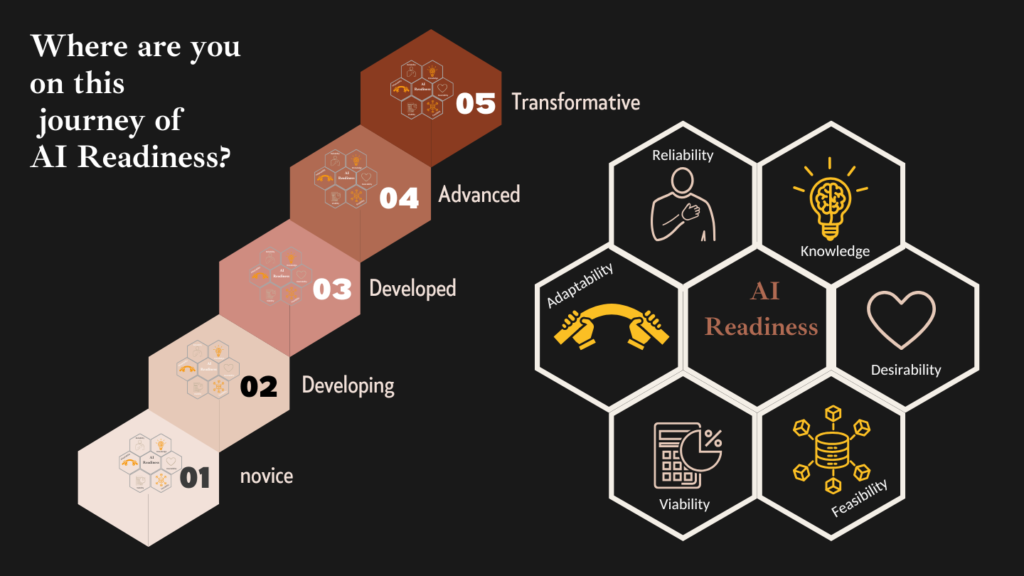

Month 10: Horizon Scanning
Can an organization be future proof?
Is it possible to ‘spot’ the future before it arrives? Or is being continuously disrupted by new technologies the norm?
In a business landscape characterized by accelerating change and complexity, the ability to not only spot trends but also make sense of them is a game-changer. This workshop is designed to teach you how to conduct deep trend analysis and horizon scanning, enabling you to foresee disruptions, anticipate shifts, and position your organization to act on emerging opportunities before your competitors even recognize them. By the end of this workshop, you will have developed the skills and systems to embed continuous trend analysis into your organization, making it a cornerstone of your strategic thinking.
How Can You Stay Ahead of Disruption?
The question isn’t whether disruption will come—it’s whether you’ll see it coming in time. How do you distinguish between fleeting fads and transformative trends? How do you sift through the noise to find the weak signals that matter? This workshop isn’t about playing defense—it’s about moving from reactive to proactive leadership, using trend analysis and horizon scanning to make smarter, faster decisions.
By the end of this month, you’ll no longer be a spectator to disruption. You’ll be an architect of the future, equipped to spot patterns, track emerging signals, and act on them long before they become industry norms.
Trend Mapping: Identifying the Signals that Matter
Trend mapping is the process of identifying, understanding, and acting on emerging trends. But it’s not as simple as tracking what’s popular today—it’s about identifying the forces that will reshape your business tomorrow. It’s about understanding how converging trends can create entirely new market dynamics.
What makes a trend more than a fad?
To understand this, we’ll introduce you to trend mapping frameworks like PESTLE (Political, Economic, Social, Technological, Legal, Environmental) and CIPHER (Contradictions, Inflections, Practices, Hacking, Extremes, Rarities). These tools will enable you to move from seeing isolated trends to identifying patterns of convergence that signal true transformation.
• PESTLE Framework: Helps you track the macro-level forces influencing your industry. What political or regulatory changes are likely to create new business conditions? How are economic forces, like inflation or supply chain disruption, driving shifts in customer behavior?
• CIPHER: This framework takes you deeper into contradictions within markets, inflection points that signal change, and the extremes that often become the next normal. This approach allows you to differentiate between the noise of fleeting trends and the true drivers of long-term change.
You will learn how to look beyond surface-level trends and analyze the underlying forces that will shape industries, technology, customer behavior, and the global economy. How do these forces converge to create new market realities? How do you identify when a trend is about to hit a critical inflection point, triggering widespread adoption or disruption?
Where to Look for Trends?
Most organizations only see what’s in front of them. Where should you be looking to find the trends others are missing? In this session, we’ll teach you how to broaden your field of vision, scanning for signals across industries, geographies, and technological frontiers. You’ll learn how to spot the seeds of disruption—those faint signals that are often dismissed but hold the potential to revolutionize entire sectors.
You will be guided through the three levels of trend scanning:
1. Macro Trends: The large-scale forces like AI, automation, and climate change that are reshaping the global economy.
2. Industry-Specific Trends: The unique shifts happening within your sector, from new regulations to emerging competitors.
3. Micro Signals: The weak signals often missed innovations emerging in startups, academic research, or niche markets that could soon explode into mainstream significance.
Horizon Scanning: Seeing Beyond the Immediate
Horizon scanning is the art of seeing what others don’t. It’s about systematically scanning for early signs of disruption and spotting the unexpected connections between trends that could reshape industries. While trend mapping focuses on recognizing patterns, horizon scanning ensures you’re looking in the right places, beyond the obvious.
In this session, we explore how horizon scanning differs from traditional market research—it’s not about tracking the past; it’s about seeing the future unfold in real time.
Where are your blind spots?
One of the key challenges in horizon scanning is recognizing the cognitive biases and mental models that limit your ability to see the future clearly. Often, organizations are blindsided by disruption not because they lacked information, but because they failed to interpret the signals correctly. You’ll be taught how to overcome these biases and broaden your perspective, ensuring you aren’t trapped by short-term thinking or incrementalism.
We’ll guide you through practical techniques for horizon scanning:
• Signal Detection: How to identify weak signals—the faint indications of change that are often ignored until it’s too late. Learn where to find the early indicators of disruption in your industry and track emerging technologies, regulatory shifts, and societal changes before they go mainstream.
• Contextual Analysis: Understand the context in which these signals are appearing. Are they part of a broader pattern of disruption, or are they isolated incidents? Horizon scanning isn’t just about finding signals; it’s about interpreting them.
We will also explore the tools and platforms used by companies like Tesla, Amazon, and Netflix to systematically scan the environment, track weak signals, and act on emerging trends.
What questions should you ask when scanning the horizon?
• Are we tracking signals across adjacent industries that could affect us in unexpected ways?
• What technological innovations are gaining traction that we’ve dismissed as too far off?
• How might geopolitical shifts impact supply chains, customer behavior, or regulatory landscapes?
Horizon scanning is about looking for the outliers—those small shifts that seem insignificant today but have the potential to completely upend your industry in the coming years.
Strategic Foresight in Action—From Insights to Action
The true power of strategic foresight lies not in spotting trends but in acting on them. This section focuses on how to take the insights gained from trend mapping and horizon scanning and turn them into actionable strategies.
How do you move from insight to execution?
You’ll learn how to integrate foresight into your strategic decision-making processes. This means using the insights from trend analysis and horizon scanning to inform your strategy and drive business innovation. You’ll build foresight roadmaps, aligning the insights you’ve gathered with your organization’s strategic objectives.
We’ll introduce you to real-world examples of companies that have successfully used foresight to make bold, industry-defining moves:
These case studies will show you how to operationalize foresight within your organization, ensuring that insights lead to decisive action.
Embedding Foresight into Your Organization’s DNA
To truly future proof your organization, foresight must be embedded into your organization’s processes, culture, and governance. Foresight isn’t a one-time exercise; it’s an ongoing capability.
We’ll explore how to:
• Build a foresight team: A dedicated group responsible for continuously scanning the horizon, identifying trends, and feeding insights into your strategic planning.
• Institutionalize foresight: Integrating foresight into your decision-making frameworks, ensuring that every strategic decision is informed by a deep understanding of future trends and weak signals.
• Create a culture of foresight: Ensuring that every level of your organization—from leadership to the frontline—is contributing to your organization’s ability to anticipate and act on future opportunities.
By embedding foresight into your organization’s DNA, you will ensure that you’re always a step ahead of disruption, continuously evolving in response to the signals and trends shaping the future.
Key Outcomes of Workshop 10:
By the end of this workshop, you will:
• Master the Foresight Mindset, equipping you to see opportunities where others see chaos.
• Develop deep skills in trend mapping and horizon scanning, allowing you to anticipate disruptions long before they impact your business.
• Gain a deeper understanding of cognitive biases that limit your ability to see the future clearly and learn how to overcome them.
• Build a comprehensive foresight roadmap that aligns your organization’s strategy with emerging trends, ensuring long-term competitive advantage.
• Institutionalize foresight within your organization, embedding it into your strategic decision-making processes, ensuring that you can continuously scan, interpret, and act on future trends.
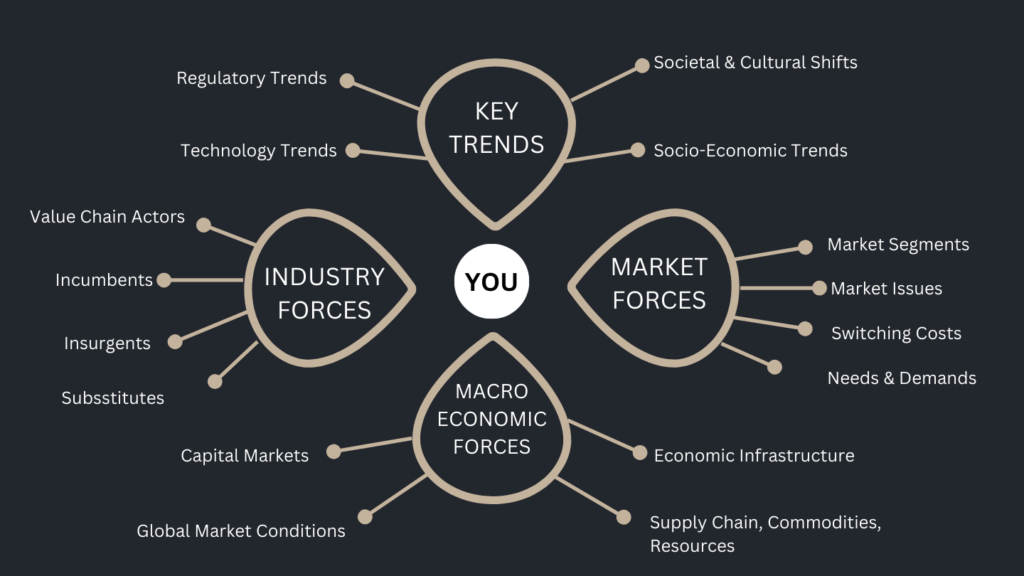

Month 11: Scenario Planning (Tomorrow Today)
The future isn’t something to wait for—it’s something to design. With the right tools and strategies, your organization can shape tomorrow, starting today.
Imagine standing at the edge of the future, with a clear understanding of the trends shaping the next decade. But how do you get there? How do you bridge the gap between the compelling vision of tomorrow and the actions you take today? This is where Scenario Planning and Back casting come into play.
workshop 11 is about making the leap from vision to execution. It’s about strategically designing multiple futures, building resilient business models, and unlocking the full potential of innovation. Here, you will shape your company’s future with intention, transforming uncertainty into opportunity.
Workshop Overview:
The Future Backwards – How Back casting Connects Vision to Reality
Many organizations plan for the future by looking forward, but Back casting turns that logic on its head. Rather than asking what comes next, you start from your vision of an ideal future and map out the steps to get there. This method shifts you from being reactive to becoming proactive, ensuring that your short-term actions are directly aligned with your long-term goals.
You will work through the back casting process, starting from the future you want to create and systematically plotting the milestones that bring you from vision to action. By learning how to reverse-engineer your success, you’ll ensure every decision today lays the foundation for tomorrow.
This session empowers leaders to map a clear, actionable path that takes them from their current state to their future ambitions. Back casting provides a roadmap that connects the present to the future with strategic clarity.
Scenario Planning – Navigating Multiple Futures
Uncertainty is a given in business. Scenario Planning equips you with the tools to anticipate different futures and build flexible strategies to thrive in any environment. Instead of preparing for one possible future, you’ll prepare for several, allowing your organization to navigate disruptions and shifts with agility.
In workshop 10, we explored how to identify and interpret trends and emerging signals through horizon scanning. Now, in Workshop 11, we move from awareness to action. This workshop is about translating those insights into real-world strategies that drive innovation and business model transformation. By utilizing back casting and scenario planning, leaders will not only anticipate change but actively shape the future by designing resilient business models and crafting actionable innovation roadmaps.
Bridging Foresight with Strategic Execution: From Signals to Strategy
Recognizing trends and shifts is just the beginning. The real challenge—and opportunity—lies in translating those signals into meaningful action for your business. How do you interpret weak signals and position your organization to capitalize on them? What strategic moves should be made today based on what you’ve seen on the horizon?
Here, it’s essential to understand the difference between strategy and strategic foresight. While traditional strategy is often inward-looking, focused on optimizing existing processes and improving performance based on current realities, strategic foresight flips that logic. Foresight looks outward—examining external forces, emerging trends, and future possibilities. It doesn’t simply optimize the present; it envisions the desired future and designs a path to get there, making organizations proactive rather than reactive.
In this workshop, we connect the dots. You’ll take the trends you mapped in workshop 10 and translate them into actionable strategies through back casting and scenario planning. This is the moment when foresight transitions from abstract thinking to strategic decision-making that directly impacts your organization’s trajectory.
Back casting: Working Backward from the Future to Shape Today
In workshop 10, you gained a comprehensive view of emerging trends and future disruptions. Now, it’s time to decide what kind of future you want to create based on those insights. Back casting flips traditional planning on its head, starting with the ideal future—shaped by the trends you’ve identified—and mapping a strategic path from that future state back to the present.
You will:
• Select critical signals from your horizon scanning efforts in workshop 10 and use them to craft a compelling vision of your future business landscape.
• Reverse-engineer your journey by outlining the specific steps and milestones required to navigate from today’s reality to your desired future state. Every decision, resource allocation, and initiative must serve the ultimate vision shaped by these signals.
• Align today’s actions with future aspirations: How do you ensure every short-term move is designed to support long-term strategic goals? This is where you move from reacting to trends to strategically leveraging them.
Scenario Planning: Preparing for Multiple Futures
With horizon scanning as your foundation, you’ll now explore scenario planning to prepare for multiple potential futures. While back casting gives you a clear pathway toward an ideal future, scenario planning allows you to remain agile and resilient by considering a variety of plausible futures, each driven by different combinations of the trends identified in workshop 10.
Here’s how you’ll use the signals from horizon scanning:
• Map out various scenarios based on different combinations of the trends you discovered. For example, how will AI, societal shifts, and regulatory changes converge to create multiple future outcomes?
• Develop adaptive strategies for each scenario, ensuring your organization can pivot effectively depending on which future becomes reality.
• Incorporate strategic flexibility: In each scenario, you’ll define the key actions and innovations needed to thrive, whether the future unfolds gradually or through radical disruption. Scenario planning ensures you are never caught off guard and can navigate multiple paths forward.
Innovation as the Strategic Response to Signals
Trends and foresight without action lead to irrelevance. Innovation is your active response to the signals identified in workshop 10. Rather than simply making incremental improvements, this workshop focuses on using innovation to create new value and reimagine business models that are resilient to future disruptions.
With the signals and scenarios from horizon scanning in mind, you will:
• Innovate new business models that capitalize on the signals identified. Which customer segments are emerging? What new value can you create based on these trends?
• Design future-proof revenue streams that not only respond to current market needs but also anticipate future shifts in technology and customer behavior.
• Ensure resilience by building business models that can adapt to multiple future scenarios—where your innovations are designed to withstand disruptive forces and maintain relevance.
Bringing It All Together – The Innovation Roadmap
This workshop will culminate in the creation of a comprehensive innovation roadmap—a strategic tool that ensures the signals identified in workshop 10 are translated into action through back casting, scenario planning, and business model innovation. The roadmap will act as a living document, guiding your organization’s journey from foresight to execution.
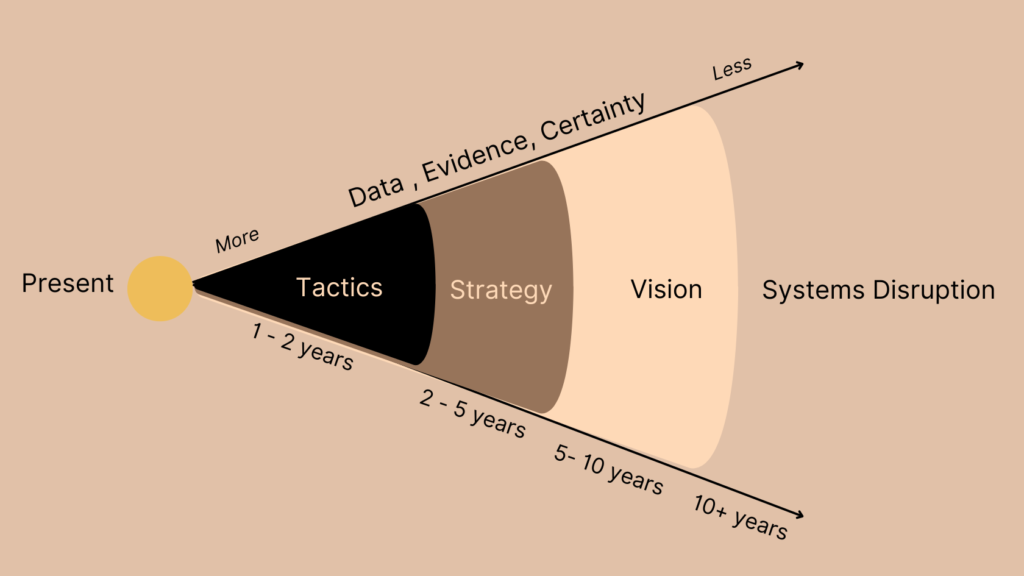

Month 12: The Adaptive Leader
This entire journey has been about the organization. In this final workshop, we shift focus to you—the organizer. Every transformation begins with you- the leader, but to sustain and evolve it, leadership too must transform. This workshop is not about the mechanics of your organization’s transformation, but about the internal mechanics of your own transformation for you will indeed be transforming for the rest of your career.
How do you, as a leader, become future-proof?
How do you stay ahead in a world where the rules are constantly being rewritten?
The traditional playbook no longer applies. As you navigate AI, digital transformation, and market disruptions, adaptive leadership will become your new norm—should you choose to accept this assignment.
The objective of this workshop is to equip you with an adaptive framework, one designed to cultivate resilience, foresight, and the agility to lead in a world of perpetual change. We introduce four core principles based upon our adaptive playbook.
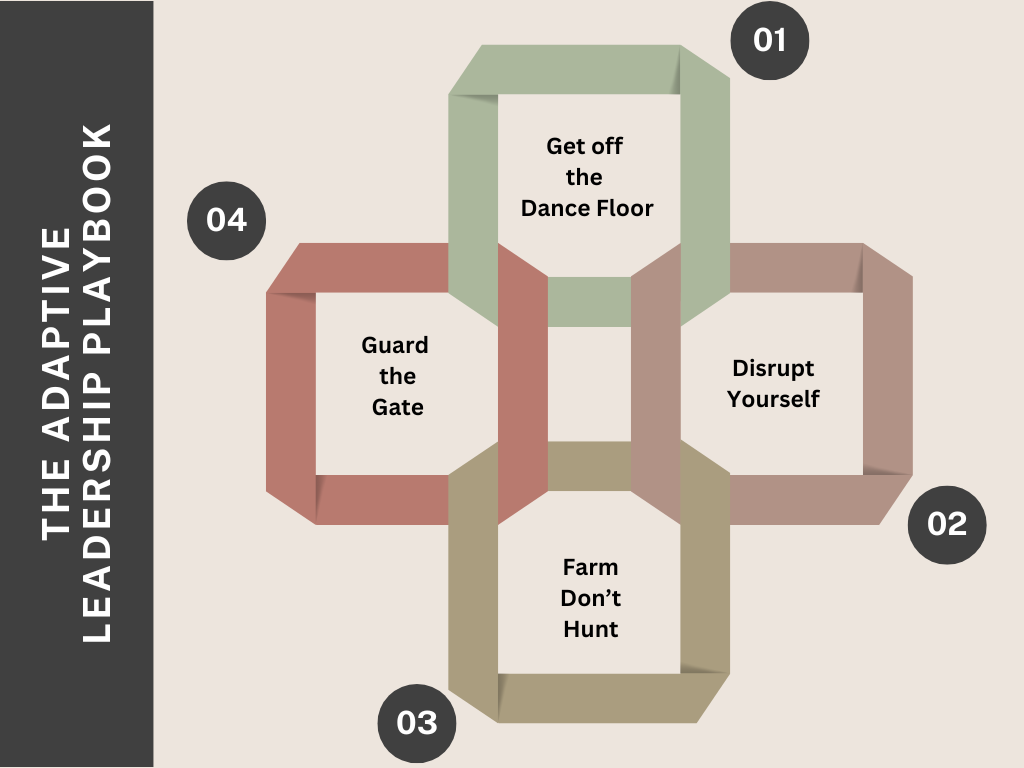
Pillar 1: Get Off the Dance Floor
How can you see the bigger picture if you’re stuck in the middle of the action?
In an era of continuous disruption, the leader’s role isn’t just about navigating today’s challenges—it’s about anticipating what’s coming next. Yet, many leaders remain absorbed in optimizing the world of yesterday, focusing on solving immediate issues without considering the larger shifts ahead. This approach is like grabbing more buckets to fetch water from a drying well instead of investing in building a pipeline for tomorrow.
This first principle of adaptive leadership invites you to rise above the day-to-day grind. “Getting off the dance floor” is about stepping back to see the broader system, understanding the forces at play. It’s about understanding what we need to do today in order to matter tomorrow. Proactive vs reactionary decision-making.
Pillar 2: Disrupt Yourself
Digital fluency, data fluency, bionic leadership. Critical to leading for tomorrow.
The greatest challenge of leadership today is not merely adjusting to external disruptions but embracing internal disruption. Leaders who continue to operate within their own comfort zones are already falling behind. Disruption begins with you—it’s about constantly evolving your leadership style, knowledge base, and mindset to remain relevant in a fast-changing world.
“Disrupting yourself” means committing to continuous learning and experimentation, even if it means challenging your most deeply held assumptions. As a leader, you can’t simply manage your team through disruption—you must be the source of disruption.
Pillar 3: Farm, Don’t Hunt
Everything your people need to bloom is within them; yours is to cultivate the right conditions for them to flourish. Focusing on controlling stifles energy. Adaptive leadership is about inspiring them to be, influencing them to want to be, allowing them to be. The responsibility of adapting is too big for any single person.
You are not the sole driver; you cannot be and shouldn’t be. You are the gardener; guiding, guarding, nourishing, tending to an environment that allows creativity, collaboration, and high performance to flourish. Your leadership shifts from top-down directives to influencing by empowering, ensuring that your team is equipped to own their success. Whether that means facilitating cross-functional problem-solving, nurturing talent through AI-driven training, or building partnerships that unlock long-term potential, your goal is to create fertile soil where growth can happen.
Pillar 4: Guard the Gate
The responsibilities and the risks are accelerating at a pace as unprecedented as the technologies themselves. No matter how tempting it is to drive along, don’t let down your vigilance. Don’t build without putting in place the safeguards. Build the safeguards in from day one. But guarding the gate isn’t just about defense; it’s about creating a culture of accountability, trust, and transparency. Leaders must not only mitigate risks but also shape the organizational culture that guides decision-making at every level. As AI and digital tools become deeply embedded in your business, the role of leadership is to ensure they are being used responsibly, fairly, and transparently. This means setting standards for ethics, governance, and responsibility in AI use.
The Leader’s Journey
Transformation leadership is not a sprint; it is an ongoing journey, a continuous sharpening of skills, perspective, and courage. Leadership in this age of AI disruption, and digital transformation requires not just vision, but an ever-deepening understanding of emerging technologies, complex systems, and evolving leadership techniques. This is about turning leadership into an active, living capability that never stops growing.
The playbook is in your hands. Now go transform again and again. The future is yours to shape
Methodology
Leading AI Transformation
Introduction to Our Core Learning Methodology
“Tell me, and I forget, teach me, and I remember, involve me, and I learn”. Rumi
The transformation of the organization begins with the transformation of the mind. Our learning methodology is designed to provoke that mind shift. We achieve this through two synergistic frameworks: the CAN Learning Framework provides the bedrock and built upon that is the Thrive Learning Experience – the process. Together they create an intellectually stimulating, hands-on, and collaborative environment where insights turn into action.
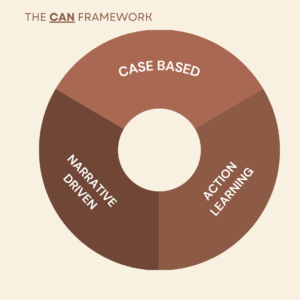
The CAN Learning Framework
CAN – short for Case-Based Learning, Action Learning, and Narrative-Driven Learning—is the engine underlying our teaching methodology. Every workshop is
1. Case-Based: Real-world case studies are discussed; they are dissected, debated, and lived. This method gives learners the tools to analyze complex situations and make critical decisions, preparing them for the dynamic challenges they’ll face in their organizations.
2. Employs Action Learning: Integrates practice assignments that executives will take back to their teams, ensuring that what they learn is immediately tested in their unique contexts. It’s learning by doing—where results matter.
3. Narrative-Driven Learning. Throughout the program, participants follow the transformation journey of a fictional company. This evolving narrative connects lessons across workshops, providing continuity and making abstract concepts relatable. It is a storytelling approach that bridges theory and practice, helping learners see the complete arc of transformation.
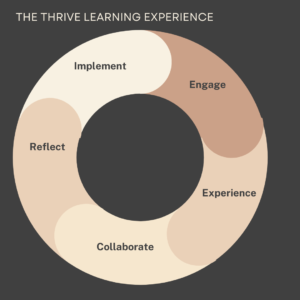
Thrive Learning Experience
Layered on top of CAN is the Thrive Learning Experience—or the process through which we ensure learning is internalized, reflected upon, and transformed into action. It takes learners through five carefully structured phases, making sure that every concept is not just learned but lived:
1. Engage: We begin by sparking curiosity and making the learning relevant to real-world challenges. This phase uses thought-provoking questions, scenarios, and immersive stories to connect emotionally with the learner.
2. Experience: Learners don’t just hear about new concepts—they experience them through hands-on activities, role-playing, and real-time problem-solving. This phase transforms theory into skills.
3. Collaborate: Peer interaction plays a critical role in leadership development. Here, learners collaborate, share insights, and challenge one another, enhancing understanding through collective wisdom.
4. Reflect & Integrate: Metacognitive exercises deepen awareness and connect the dots. Through reflection and feedback, knowledge solidifies, preparing learners for action.
5. Transform & Implement: The final phase pushes participants to turn their learning into action. Through roadmaps, leadership playbooks, and team assignments, learners build plans that drive long-term, tangible results in their organizations.
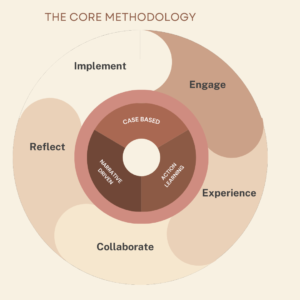
Tools and Resources
Throughout the program, learners will have access to a rich repository of tools, templates, and workbooks that support the CAN and Thrive frameworks.
This methodology, refined through years of iteration and practical application, equips leaders to tackle the complexities of AI and digital transformation head-on. It is not just about surviving disruption—it is about thriving within it.
Industries
This service is primarily available to the following industry sectors:

Finance
History:
The finance industry has always been a cornerstone of global economic development, evolving alongside major technological and regulatory advancements. The 20th century witnessed the consolidation of many financial institutions, the creation of central banks, and the rise of modern investment vehicles, including mutual funds and derivatives. In the late 20th century, the advent of digital banking transformed how consumers interacted with financial institutions. The 1980s and 1990s introduced innovations such as ATMs, electronic trading platforms, and the early forms of online banking, all of which laid the groundwork for the digital financial ecosystem of today.
The early 2000s saw the rapid digitization of the finance industry, driven by the internet’s expansion and mobile banking technologies. Following the 2008 financial crisis, regulatory measures like Basel III were implemented to strengthen risk management in banking institutions. As financial institutions recovered, the rise of fintech companies began to challenge traditional banking models, offering online services such as peer-to-peer lending, mobile payments, and robo-advisory platforms.
Current Position:
Today, the finance sector is characterized by digital transformation and fintech disruption. AI and blockchain are reshaping everything from customer interactions to back-office operations. Instant payments and real-time processing are becoming the norm, accelerated by innovations like the Federal Reserve’s FedNow service, which brings financial institutions closer to achieving instantaneous financial transactions. In this environment, financial institutions are increasingly pressured to adopt blockchain-based solutions for security and transaction efficiency.
Additionally, customized investment portfolios, driven by the demands of younger generations such as Gen Z, have gained momentum. Gen Z’s values around environmental, social, and governance (ESG) concerns are prompting asset managers to create highly customized, values-based investment portfolios through AI platforms. Large institutions like JPMorgan and Amundi are leveraging AI to offer personalized investment strategies that align with the ethical considerations of their clientele.
Furthermore, open banking frameworks are creating new opportunities for third-party fintech companies to offer customized financial services directly through banks’ APIs. This move towards greater transparency and integration, especially with the passing of the Payment Services Directive 3 (PSD3) in the EU, underscores the growing collaboration between traditional financial institutions and fintech disruptors.
Future Outlook:
The future of finance will be shaped by decentralization, AI, and cryptocurrency. As blockchain technology matures, financial institutions will increasingly rely on decentralized finance (DeFi) models to streamline transaction processes, improve data security, and lower costs. Banks and payment providers are already exploring the use of tokenized payments to eliminate traditional credit and debit card infrastructures, a move signaled by Mastercard’s recent launch of tokenized payments. This trend towards tokenization may usher in the end of physical credit cards in favor of digital wallets and other virtual payment systems.
Additionally, financial institutions must adapt to the impending cashless society. As global consumers transition away from cash in favor of digital payment platforms, banks will need to develop digital currencies and advanced digital payment solutions to remain competitive. Cryptocurrencies and central bank digital currencies (CBDCs) are expected to play a pivotal role in the future of finance. Countries worldwide, including those within the European Union, are already experimenting with CBDCs, which could provide a more secure and efficient alternative to traditional fiat currencies.
AI-powered automation will also continue to transform the finance sector, with neobanks gaining further market share through streamlined, tech-driven financial services. Traditional banks will face pressure to adopt similar innovations to offer real-time payments, fraud detection, and personalized financial solutions. Finally, cybersecurity will remain a critical focus area as financial institutions battle increasingly sophisticated cyber threats. The integration of biometric security and digital identity verification technologies will further enhance the security of financial transactions in a digital-first world.
Retail & E-commerce
History:
Retail has a deep-rooted history that dates back centuries, with the traditional model of brick-and-mortar stores dominating much of the 20th century. Initially, these stores were centralized marketplaces where customers visited to purchase goods, often relying on face-to-face interactions with salespeople. By the mid-20th century, chain stores and larger department stores began to shape the industry, offering a wide array of goods in more structured formats. The late 20th century saw the emergence of e-commerce with the rise of the internet, fundamentally shifting the way consumers shopped. Retailers like Amazon and eBay pioneered this shift, offering consumers convenience, wider product selections, and competitive pricing.
The 2000s ushered in a mobile shopping revolution, with smartphones enabling consumers to shop from anywhere. This led to the rise of mobile-first e-commerce platforms, loyalty programs, and digital payments, which continue to evolve. However, for much of its history, retail has been a highly fragmented industry, with slow adoption of digital technologies by traditional retailers until the 2010s.
Current Position:
Retail is now undergoing a profound transformation driven by AI and hyper-personalization. Today’s consumers expect a seamless omnichannel experience, combining in-store and online shopping into a unified, personalized journey. AI-powered recommendation engines, chatbots, and virtual assistants are creating tailored shopping experiences by analyzing consumer data in real time. This shift is driven by the need to cater to individual customer preferences, offering personalized promotions, dynamic pricing, and curated product recommendations.
Retailers like Amazon and Walmart are at the forefront of implementing AI to enhance inventory management, supply chain efficiency, and predictive analytics. These innovations allow retailers to manage demand more accurately, prevent stockouts, and optimize pricing strategies. Additionally, augmented reality (AR) is gaining traction, with retailers like Ikea and Walmart allowing customers to visualize how products will look in their own homes before making a purchase. AR mirrors in stores, such as those introduced by Nike and Men’s Wearhouse, enable shoppers to virtually try on clothes.
The integration of nano-fulfillment centers is also transforming the supply chain, making same-day delivery and hyperlocal fulfillment possible. These centers, often automated with AI-driven robotics, enable faster and more cost-effective last-mile delivery, allowing retailers to meet the growing demand for rapid e-commerce services.
Future Outlook:
The future of retail will continue to be defined by AI-driven hyper-personalization and immersive technologies. AR and VR will become even more integral to the shopping experience, allowing consumers to interact with products digitally in both online and physical environments. AI will take personalization to new heights, enabling retailers to offer adaptive shelves and dynamic product displays that change based on real-time customer preferences and environmental conditions. These innovations will create deeply personalized shopping journeys, both online and in stores.
General-purpose robots will also play a significant role in retail logistics, from warehouse automation to customer service. These robots will handle a variety of tasks, including product stocking, order fulfillment, and customer assistance, drastically reducing operational costs and enhancing efficiency. Moreover, drone fleets and autonomous delivery vehicles will further revolutionize last-mile delivery, offering rapid and cost-effective options for both urban and rural customers.
Additionally, retailers will embrace emotion recognition technology to enhance customer interactions, predicting consumer behavior and optimizing sales strategies based on real-time emotional cues. Biometric payments and contactless checkouts will become standard, making the shopping experience more frictionless and secure. With the rise of nano-fulfillment centers, retailers will continue to push for faster and more efficient e-commerce fulfillment, reshaping urban landscapes with localized, automated warehouses.
Healthcare
History
The healthcare industry has consistently been at the forefront of adopting emerging technologies. From the digitization of health records in the late 20th century to the integration of AI in diagnostics and treatment, technology has played a central role in transforming healthcare delivery. One of the earliest adopters of computer technology, the pharmaceutical industry began using computational methods for drug discovery in the 1960s, and this laid the foundation for AI’s more recent role in speeding up drug development.
Technological innovations such as genomic sequencing, bioengineering, and CRISPR gene editing have also made personalized medicine a reality. AI has improved healthcare delivery by enabling automated diagnosis through machine learning models and enhancing clinical decision-making processes. Wearable technology, which began with fitness trackers, evolved into real-time health monitoring devices that provide clinicians with valuable data for more personalized treatments.
Current Position
Today, healthcare is driven by AI, bioengineering, and the increasing use of digital twins. AI algorithms are widely used for medical imaging, clinical decision support, and predictive analytics, improving patient outcomes and enabling faster diagnostics. For instance, AI tools like IDx-DR and Viz.ai detect anomalies in imaging scans, improving diagnostic accuracy. Similarly, AI is helping with personalized medicine by analyzing genomic data to tailor treatments to the specific needs of individual patients.
The use of digital twins is rapidly expanding in healthcare, allowing for highly personalized and predictive care. A digital twin is a virtual replica of a patient, created using real-time data, to simulate potential outcomes of medical treatments. These twins are particularly valuable for simulating the effects of medications or surgeries before performing them on patients, reducing risk and improving precision.
Moreover, bioengineering breakthroughs like CRISPR have paved the way for gene editing to treat previously untreatable diseases at the genetic level. This includes the potential for in vivo gene editing, where corrections can be made directly in a patient’s body. AI is also playing a crucial role in accelerating drug discovery, particularly in the development of AI-designed molecules, which are already moving into clinical trials.
Future Outlook
Looking ahead, the role of digital twins is set to grow exponentially as they become more integrated into healthcare systems. By simulating organs or even full-body digital twins, medical professionals will be able to model disease progression, test treatment outcomes, and provide highly personalized care for patients. This will transform predictive medicine and enable better management of chronic diseases.
AI-first drug development is expected to continue accelerating, with pharmaceutical companies using AI to discover new treatments and predict how they will interact with diseases. The expansion of in silico trials, where drugs are tested using computer simulations instead of human subjects, is expected to cut down costs and bring drugs to market faster. Generative AI will also continue to revolutionize antibody design, developing novel antibodies that may be more effective than those designed by nature.
As CRISPR and gene-editing technologies evolve, in vivo gene editing will likely become commonplace, allowing for genetic disorders to be treated in real-time within the body. These treatments, combined with AI-powered diagnostics and predictive tools, will redefine the patient experience, enabling proactive healthcare that prevents disease rather than simply treating it after symptoms appear.
The rise of cyberbiosecurity will be crucial as healthcare data becomes more interconnected across digital platforms, ensuring the protection of patient privacy in an increasingly digital world. Finally, AI-driven mental health solutions, such as conversational agents and virtual therapy platforms, will continue to play a role in addressing global mental health challenges.
In summary, the healthcare industry is moving towards a future that is predictive, personalized, and digitally enabled, with AI and digital twins at the center of this transformation. These advances promise not only to improve patient outcomes but also to lower healthcare costs and expand access to medical treatments worldwide.
Insurance
History:
The insurance industry has a rich history, dating back to ancient civilizations where early forms of risk-sharing agreements were made to mitigate potential losses. Early maritime insurance in the Renaissance was a significant turning point, formalizing the industry as traders sought protection from the unpredictable dangers of sea travel. Over time, the industry expanded to encompass life, health, and property insurance, growing in sophistication alongside modern economies. The 20th century saw the birth of modern health and life insurance systems, largely fueled by rising industrialization and increasing complexity in business and personal lives. By the late 20th century, digitization began to take hold, laying the groundwork for the next technological evolution: AI and data analytics.
Current Position
The insurance industry is currently in the midst of profound transformation. Traditional models, which once relied heavily on manual processing, are now evolving into data-centric and AI-powered frameworks. Companies are integrating AI across multiple areas of the value chain:
1. Predictive Analytics: AI has transformed risk assessment and underwriting processes, enabling more precise risk evaluation based on vast datasets. Wearable technology, IoT, and telematics in cars are providing real-time data that allows insurers to create personalized risk profiles. Insurers like Liberty Mutual and Lemonade are leading the charge with AI-powered systems for both policy issuance and claims management.
2. Claims Automation: AI-driven systems dramatically reduce the time and cost associated with claim processing. For example, AI tools are now using image recognition to assess damage from car accidents or natural disasters, as seen with Sompo Japan’s collaboration with Tractable. Computer vision models are applied to evaluate vehicle damage or property loss in real-time, expediting payouts and improving customer satisfaction.
3. Robo-Advisers: Increasingly, AI-powered robo-advisers like Wealthfront are helping consumers make informed investment decisions by assessing financial goals and risk tolerance. This trend represents a shift toward low-cost, scalable financial advice, offering broader access to wealth management.
4. AI and Liability Insurance: Emerging risks, particularly around AI systems themselves, are forcing insurers to innovate. AI failure, such as in self-driving cars or misdiagnosed health conditions, has led to the development of new liability insurance models to account for machine learning systems’ potential errors.
The ongoing integration of AI is not without its challenges. Cybersecurity and ethical concerns around data usage and privacy remain at the forefront of discussions, especially as insurers rely more heavily on sensitive personal data for underwriting and claims decisions.
Future Outlook
The future of the insurance industry is marked by a shift toward a more automated, data-driven ecosystem, with AI playing a central role in underwriting, risk management, and customer interaction. Here are key trends shaping the future:
• Digital Twins: One of the most exciting advancements in insurance is the application of digital twins—virtual replicas of physical entities like buildings, factories, or even people. By creating these virtual models, insurers can predict potential damage or failure scenarios in real-time, offering proactive maintenance or disaster prevention solutions. For instance, a digital twin of a building can be used to assess structural integrity continuously, enabling insurers to reduce risks before they escalate into claims.
• Cyber Insurance: As businesses adopt more AI-driven tools, the demand for AI-specific insurance models, particularly in cybersecurity, will increase. Insurers will need to offer policies that protect against AI-related failures, from data breaches to AI-driven malfunctions in autonomous vehicles or medical devices. The emergence of cyberbiosecurity—addressing risks associated with bioengineering and AI—will require specialized insurance models that blend cybersecurity with biosecurity concerns.
• AI-Enhanced Customer Experience: AI is expected to further enhance the customer experience through hyper-personalization. By leveraging natural language processing (NLP), AI can offer 24/7 support via chatbots, process claims in minutes, and tailor policies based on real-time behavioral data. This could mark the end of traditional, static insurance policies in favor of dynamic, on-demand coverage.
• Wearable Tech and IoT: Insurers will increasingly rely on wearable technology and IoT devices to collect health and behavioral data for real-time policy adjustments. This “connected insurance” model offers the potential to reduce premiums for customers engaging in healthy behaviors or adopting safe driving practices. Companies like Honeywell are already leading the charge with wearable devices for workplace safety.
• Sustainability and ESG: Socially conscious investing and Environmental, Social, and Governance (ESG) criteria are gaining traction, with AI helping insurers assess and manage portfolios aligned with these values. AI will enable insurers to offer more sustainable investment products and help them assess climate risks with greater accuracy.
In summary, the future of the insurance industry will be shaped by AI-driven efficiencies, personalized customer experiences, new insurance models addressing AI risks, and innovations like digital twins and cyber insurance. Insurers must navigate these advancements carefully, ensuring that technology aligns with ethical standards and customer trust.

Education
History:
Education has evolved from oral traditions and handwritten manuscripts to the printing press, which revolutionized access to knowledge. The rise of public education in the 19th and 20th centuries standardized education systems across much of the world, offering structured learning environments for broad populations. However, these systems often relied on a “one-size-fits-all” model, which didn’t accommodate the individual learning styles and needs of students. The integration of technology in the late 20th century, from personal computers to the internet, brought about new methods of teaching and learning, such as online courses, digital resources, and remote learning platforms. These tools began to transform how education was accessed and delivered, but it was still largely content-driven, rather than personalized.
Current Position:
Today, AI is fundamentally reshaping education by enabling personalized, adaptive learning experiences that adjust to individual student needs. Khan Academy’s Khanmigo is a prime example, where AI-powered learning tools act as interactive tutors, guiding students through problems, asking questions, and offering real-time feedback based on the learner’s performance. This model allows for a scalable, personalized education that can meet students where they are, allowing for a much deeper engagement with the material.
In addition, immersive technologies like VR (Virtual Reality) are expanding the boundaries of traditional learning. For example, Morehouse College uses VR in its chemistry labs, resulting in higher test scores compared to conventional methods. Similarly, Japan’s N and S high schools leverage VR headsets for collaborative learning experiences, demonstrating that immersive education can be scaled effectively.
Moreover, digital twins are beginning to enter the educational sphere, creating highly detailed virtual simulations that mimic real-world conditions. In healthcare education, for instance, digital twins can model patient scenarios, allowing medical students to practice diagnostic techniques and treatment planning in a risk-free environment. These simulations allow students to engage deeply with material that would be too dangerous or difficult to explore in the real world.
Future Outlook:
Looking ahead, the education sector is poised to become even more dynamic, personalized, and inclusive through continued AI and VR integration. With technologies like AI chatbots, personalized learning platforms, and immersive worlds gaining traction, we can expect a future where learning is more interactive, student-centered, and adaptable to individual learning styles. AI-powered robots like KeeKo, used in some classrooms to facilitate early childhood learning, represent a future where AI assists in both teaching and emotional development.
Metaverse-based learning environments will also likely gain prominence, creating global classrooms that transcend geographical barriers. RoybiVerse, for example, offers a virtual platform where learners can engage in multisensory, immersive experiences, manipulating molecular structures or walking through historical eras.
One key area of growth is in AI-driven assessments that allow for more precise measurements of student understanding, beyond traditional exams. AI will also support ongoing, personalized feedback loops that adjust learning pathways based on student progress. Khanmigo and other AI tutors will continue to scale, reaching more students globally and transforming the role of the educator into a more facilitative and mentoring role.
However, ethical concerns around data privacy, surveillance, and equity of access must be addressed. As AI tools collect more detailed data on student behaviors and performance, safeguarding student information will become increasingly critical to maintaining trust and ensuring that technology serves all learners equally.
Locations
This service is primarily available within the following locations:

New York – United States
New York has long been a global hub for finance, insurance, and technology. Known as the world’s financial capital, it boasts the headquarters of some of the largest banks, insurance companies, and fintech firms. As early as the 1960s, the city began laying its groundwork as a tech hub, particularly in financial services, with Wall Street’s dominance in driving innovations in banking technology. Over the decades, New York attracted a high concentration of global talent, further solidifying its standing as a center for technological innovation, including early AI applications in finance and media.
Today, New York’s status as a global tech powerhouse is reflected in its vibrant AI ecosystems across fintech, insurtech, and medtech. Companies like Goldman Sachs and JPMorgan Chase are leading in AI-driven banking and fintech innovation, from algorithmic trading to personalized financial products. In insurance, AI is being applied for fraud detection, underwriting, and claims automation. Moreover, New York’s universities and research centers are at the forefront of advancing AI in education, with projects such as Khan Academy’s Khanmigo creating new possibilities for personalized learning. The city’s thriving health tech sector is also adopting AI to improve medical imaging, drug discovery, and patient diagnostics.
New York’s integration of AI will continue to disrupt sectors like fintech and medtech, with digital twins expected to revolutionize healthcare and urban planning. Fintech firms will increasingly leverage AI for real-time risk assessment and personalized financial services. Additionally, the state is pushing for AI-driven solutions to manage urban infrastructure and healthcare systems, enhancing the quality of life in the city. As AI continues to be integrated into daily life, New York is positioned to remain a leader in AI, medtech, and fintech innovation.

Singapore
Singapore has rapidly evolved from a small trading port into a global financial and technological hub. Known for its efficient governance and forward-thinking policies, Singapore has consistently pushed the envelope in adopting advanced technologies, including AI. In the 2000s, the government launched initiatives like Smart Nation to establish the city-state as a leader in digital innovation. With a strong financial backbone, Singapore was one of the early adopters of fintech and insurtech, encouraging both local and international players to invest in AI-driven solutions.
Today, Singapore is at the forefront of AI applications across various industries, particularly fintech, medtech, and education. AI Singapore, a government-led initiative, accelerates AI research and industry adoption. Major banks and insurance companies in Singapore are leveraging AI to enhance fraud detection, underwriting processes, and customer service. In the medtech sector, AI plays a critical role in diagnostics, personalized medicine, and healthcare robotics. Singapore’s education system is also pioneering AI-driven personalized learning, utilizing platforms like Khan Academy’s Khanmigo to drive adaptive learning models that cater to students’ unique needs.
Singapore’s future is tied to its ongoing commitment to AI across finance, healthcare, and education. Digital twins and smart city technologies will become more integral to its urban planning and healthcare systems, ensuring predictive maintenance and personalized healthcare delivery. The fintech sector will see more AI-driven services such as real-time fraud detection, risk modeling, and personalized banking. Singapore’s leadership in AI adoption will ensure its place as a global hub for innovation in fintech, medtech, and education technology.

Boston – United States
Boston has long been known as a center for education, healthcare, and biotechnology, with institutions like Harvard and MIT driving research and innovation. The city’s strong foundation in medical research and pharmaceutical development has historically made it a leader in healthcare advancements. As the biotech industry grew, so did Boston’s reputation as a global hub for healthcare and medical technology innovation. The city’s focus on research and higher education attracted top talent, fostering an environment ripe for innovation, particularly in medtech and digital health.
Boston is now a global leader in medtech, with AI playing a significant role in transforming healthcare. From AI-powered drug discovery and clinical trials to personalized medicine and digital twins, Boston is at the cutting edge of medical innovation. Leading hospitals and research centers in Boston are utilizing AI to improve diagnostics, patient outcomes, and medical research. In education, institutions like MIT and Harvard are exploring AI-driven personalized learning solutions, and the city’s vibrant fintech ecosystem is expanding through AI applications in finance and insurance.
Boston’s medtech and digital health sectors will continue to expand as AI and machine learning play an increasingly important role in drug discovery, diagnostics, and patient care. The integration of digital twins into healthcare could revolutionize how clinical trials are conducted and treatments are personalized. AI-driven education will continue to evolve, particularly in higher education and specialized training, positioning Boston as a leader in both healthcare and education innovation.
London – United Kingdom
As one of the world’s oldest financial hubs, London has always been at the center of global commerce and banking. Over the years, the city has also become a leader in technological innovation, particularly in financial services, media, and education. The early 2000s saw a wave of fintech companies emerging from London, leveraging the city’s position as a global financial leader. In education, London’s universities have been at the forefront of research in AI, while its media industry has consistently adopted new technologies.
London is a thriving hub for fintech, insurtech, and education innovation. AI-driven solutions are revolutionizing banking and insurance in London, with companies leveraging machine learning for fraud detection, risk assessment, and customer service automation. Education technology is also expanding, with AI tools being used to deliver personalized learning experiences at scale. Khan Academy’s Khanmigo and other AI platforms are gaining traction in London’s education landscape. Additionally, the city’s media industry is increasingly relying on AI for content creation, distribution, and audience engagement.
London is poised to continue its leadership in fintech, edtech, and AI-driven media. The adoption of AI across finance, insurance, and education will grow, with digital twins playing a key role in urban development and healthcare. The city’s insurtech sector will further develop as AI takes on more predictive and diagnostic tasks. In education, AI will continue to shape personalized learning experiences, and London will remain a key player in AI innovation across multiple sectors.

Nairobi – Kenya
Nairobi has been the center of East Africa’s tech and financial ecosystem, known as “Silicon Savannah.” Kenya has a rich history of digital innovation, starting with the revolutionary launch of M-Pesa in 2007, which introduced mobile banking to millions of unbanked individuals. This marked Nairobi as a leader in fintech for developing nations, attracting significant international interest in tech innovation.
Today, Keya is leading the continents AI agenda by being one of the first to develop a National AI strategy. Nairobi’s fintech and mobile banking solutions are continuing to evolve through AI. M-Pesa remains a dominant force, and AI is being incorporated into mobile banking platforms for fraud detection and personalized financial services. Nairobi has also emerged as a growing center for edtech, with AI-driven tools being adopted to improve educational outcomes, especially in underserved areas. The city is also beginning to see the rise of health tech, where AI is helping to improve diagnostics and resource allocation in healthcare systems.
Nairobi is set to become a leading hub for AI-driven fintech and insurtech in Africa. As mobile-based financial services expand, AI will play an increasingly critical role in delivering personalized and secure banking solutions. The city’s education sector will continue to benefit from AI-driven learning platforms, while medtech innovations will enhance healthcare access and diagnostics. Nairobi’s role as a hub for innovation in Africa will only grow, with the city likely to become a leader in AI adoption across multiple sectors.
Program Benefits
Management
- Strategic Clarity
- Decisive Action
- Clear Prioritization
- Strategic Agility
- Avoid Obsolescence
- De-Risked Decisioning
- Navigate Ambiguity
- Operational Agility
- Competitive Edge
- Cost Optimization
Information Technology
- Accelerated Innovation
- Unified Strategy
- Scalable Infrastructure
- Risk Mitigation
- Eliminate Waste
- Enhanced Reliability
- Simplified Workflows
- Automation Gains
- Co-ordinated Teams
- Compliance Readiness
Human Resources
- Improved Engagement
- Optimized Resources
- Future-Ready Workforce
- Adaptive Workforce
- Enhanced Talent
- Galvanized Organization
- Empowered Teams
- Simplified Operations
- Sustained Retention
- Enhanced Analytics
Testimonials
Partner, Next Street
“Unlike any leadership training I’ve been through. Every session left me with actionable insights, and the narratives were so real, so relevant that we never forgot what we learned. The team completely overhauled its approach to innovation, thanks to the insights from the session. This literally saved us hundreds of thousands of wasted resources in ‘bad’ ideas.”

PRO(former), Kenya Ports Authority
“The Clarity session was exactly what we needed to stop wasting money on maybe efforts. If it wasn’t for Ms. Eriaku’s team, we would still be doing maybe’s. Now we have divested, pivoted and doubled down in what truly matters. ”
Former CEO, Heritage Oil & Gas
“Our industry was evolving rapidly, and we knew that old ways of working would not work , we had to shift our employees’ mindsets toward embracing innovation. Ms. Eriaku’s program delivered quite successfully to provide the tools needed to instill a culture of continuous learning and innovation. We had a near 93% engagement rate with the Powerup challenges. What an effective way to upskill our workforce”
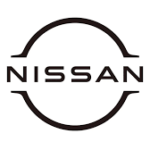
Corporate Strategy Lead— Nissan Motorcare
“We initially chose a simple advisory session thinking that’s all we needed. A simple executive session turned into a year-long journey of rebuilding our thinking, our operations, our strategy. Without a doubt, it was the clarity and confidence from that first session that set us on this path of futureproofing. Now foresight is embedded into our strategy sessions. Such a difference it has made in informing investment decisions.”
More detailed achievements, references and testimonials are confidentially available to clients upon request.
Client Telephone Conference (CTC)
If you have any questions or if you would like to arrange a Client Telephone Conference (CTC) to discuss this particular Unique Consulting Service Proposition (UCSP) in more detail, please CLICK HERE.











